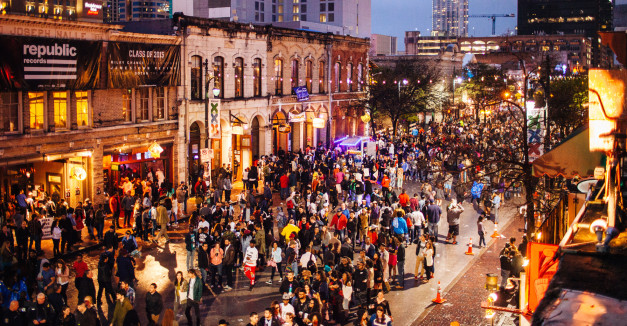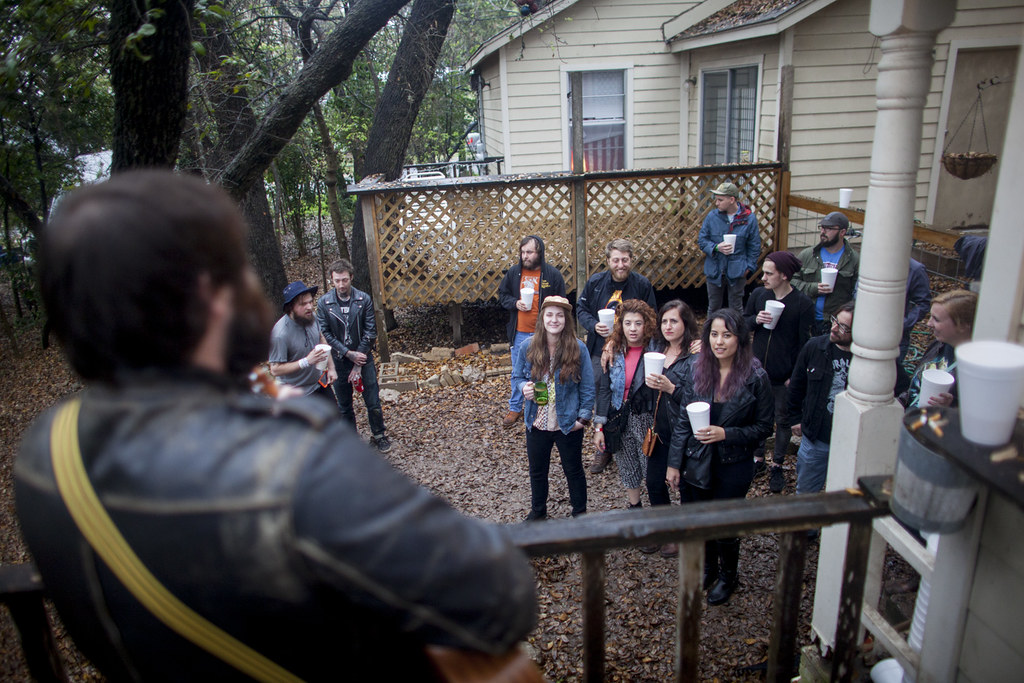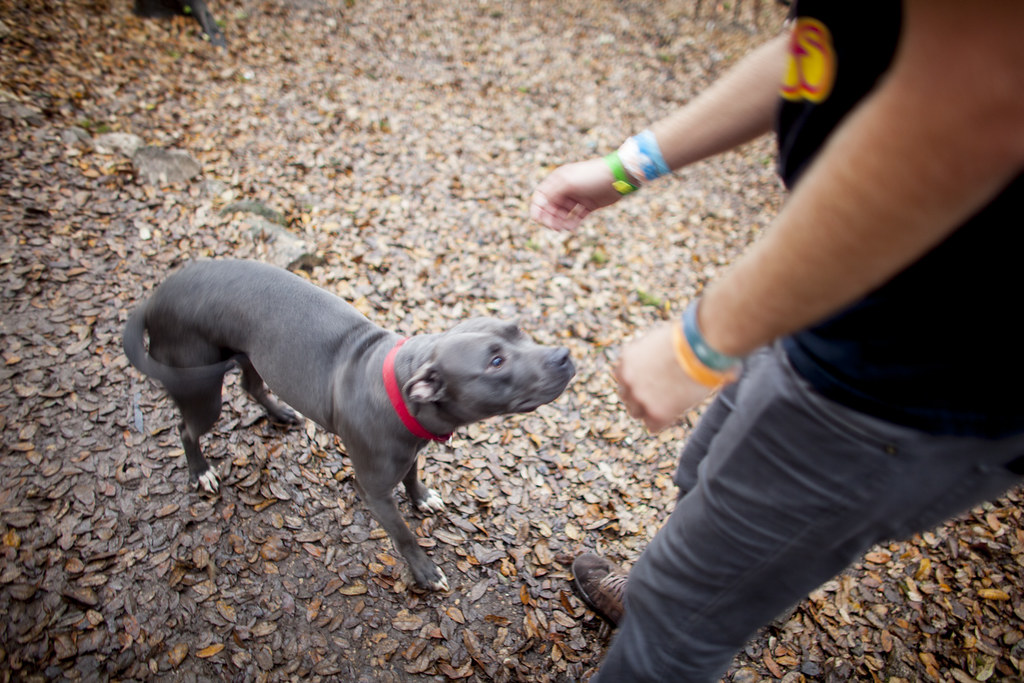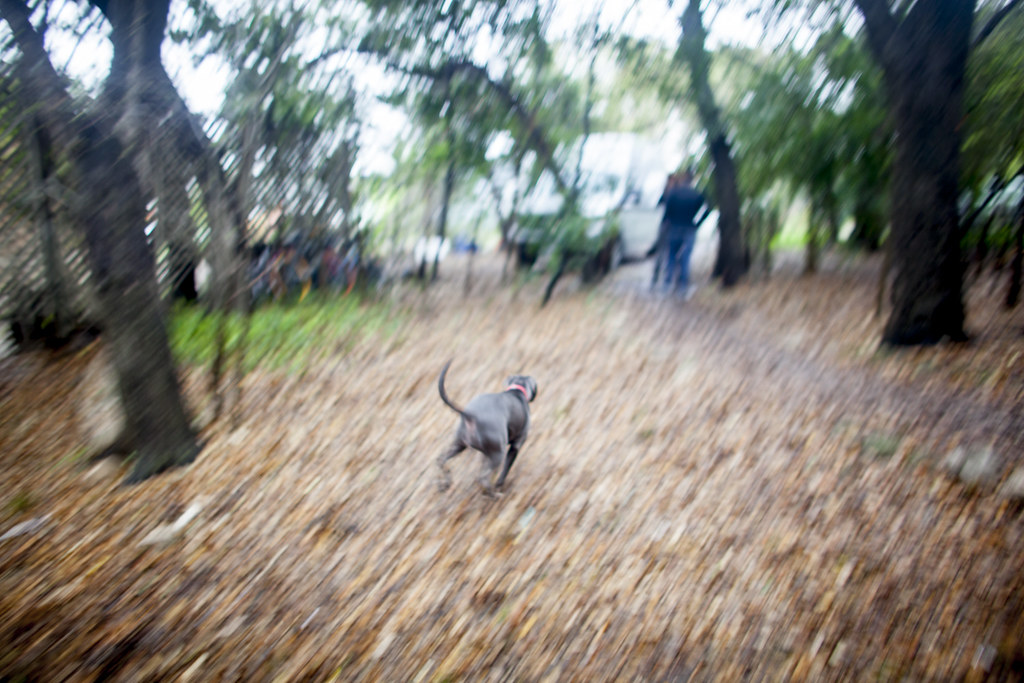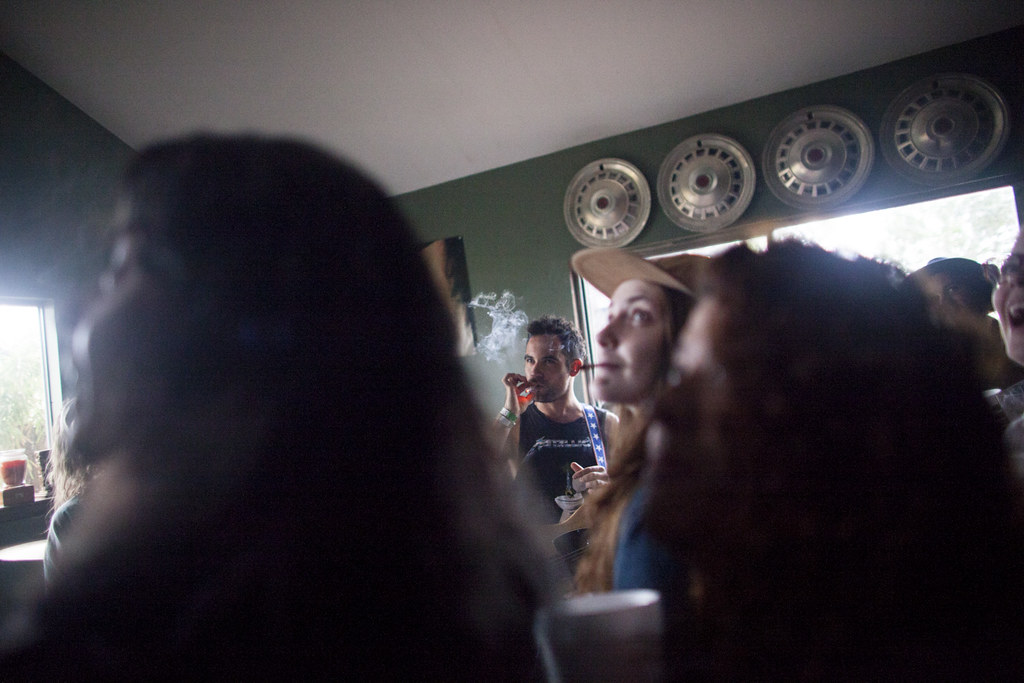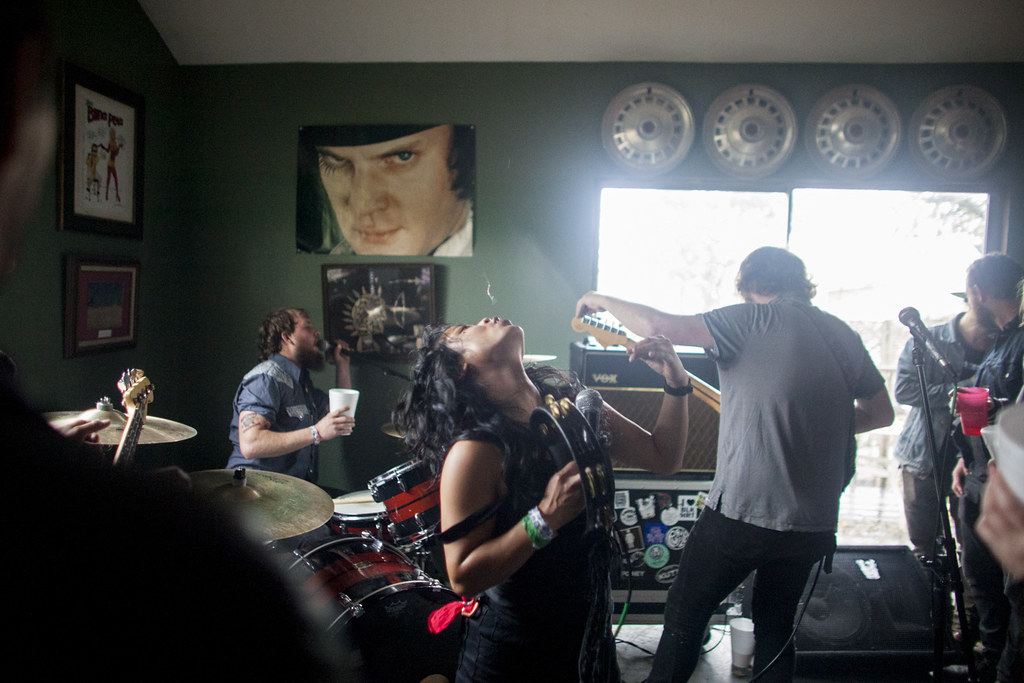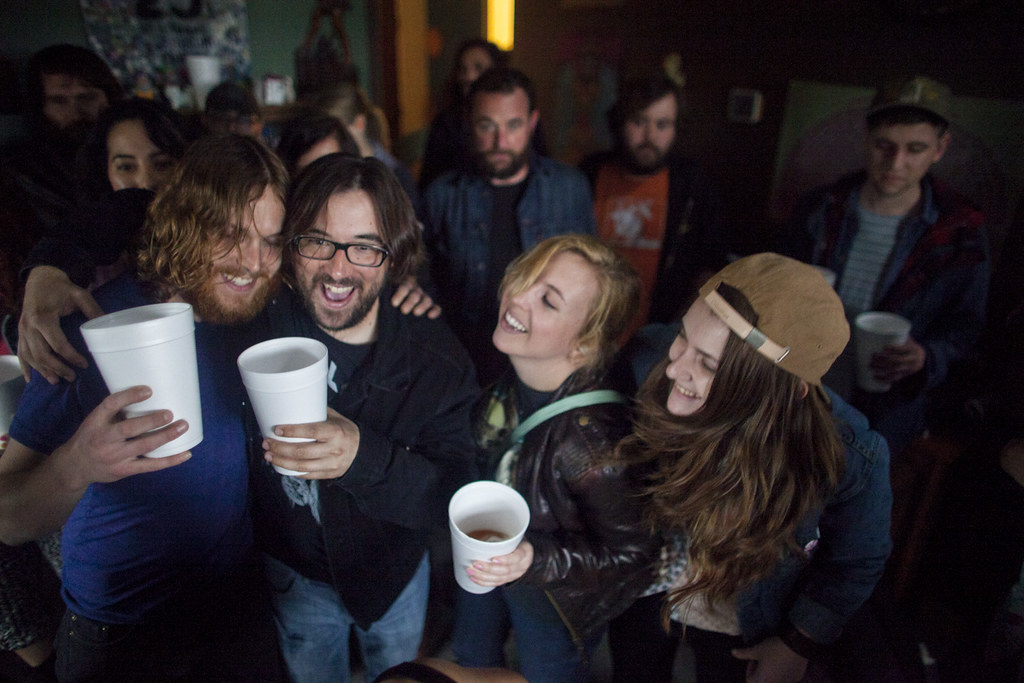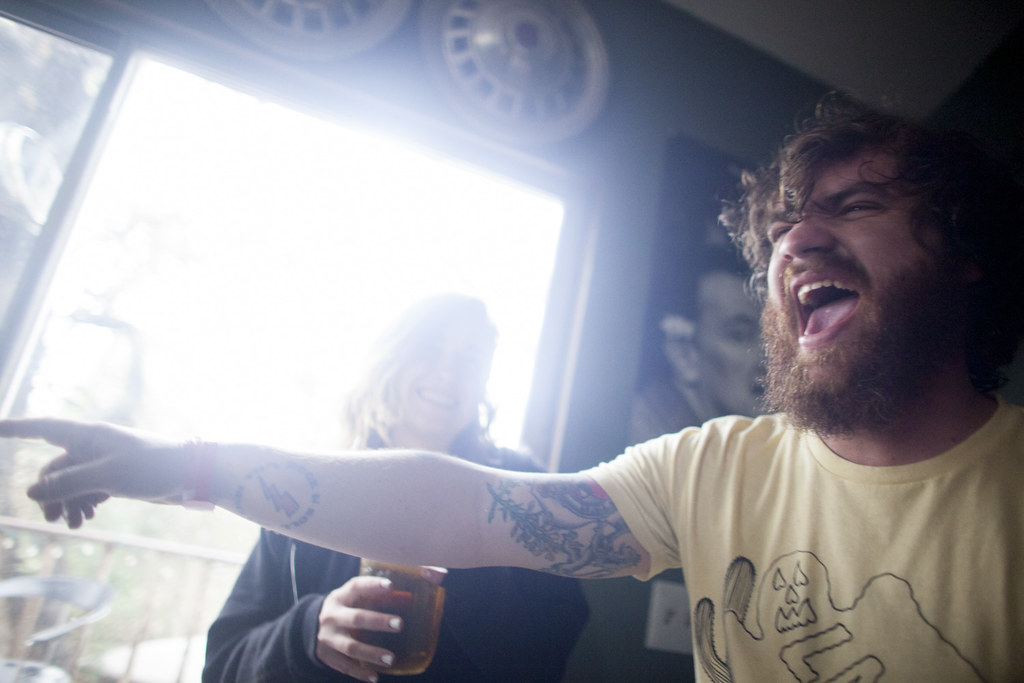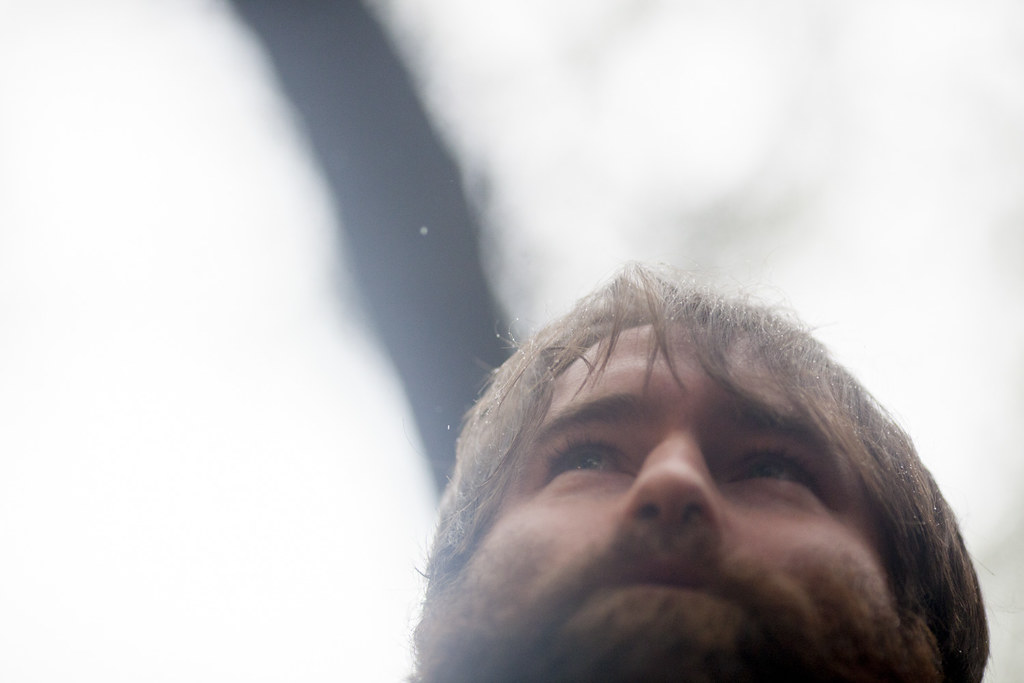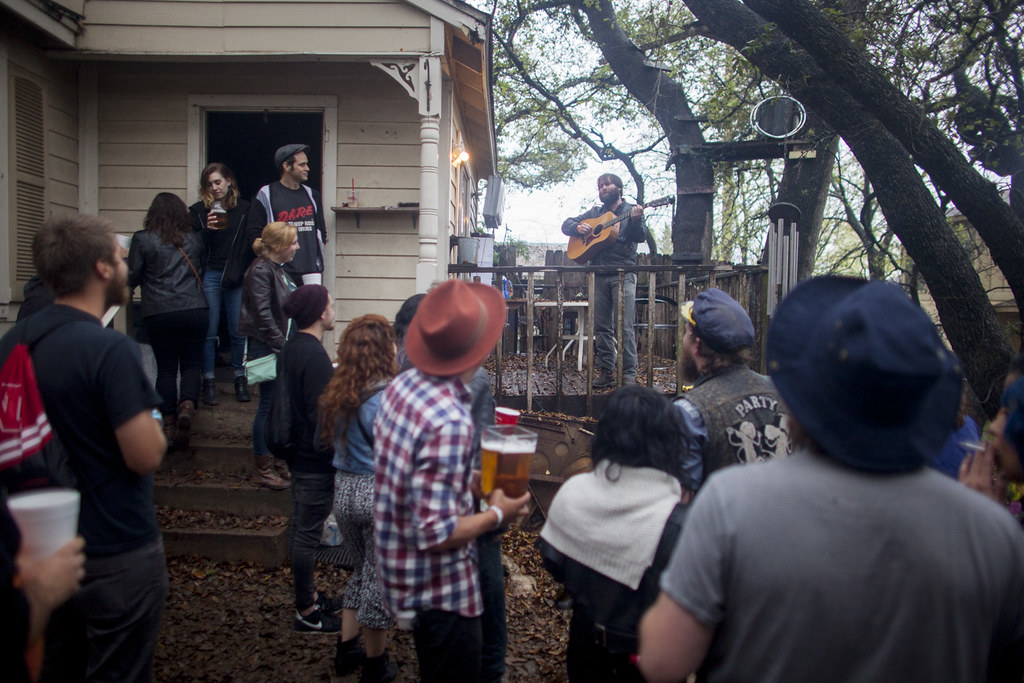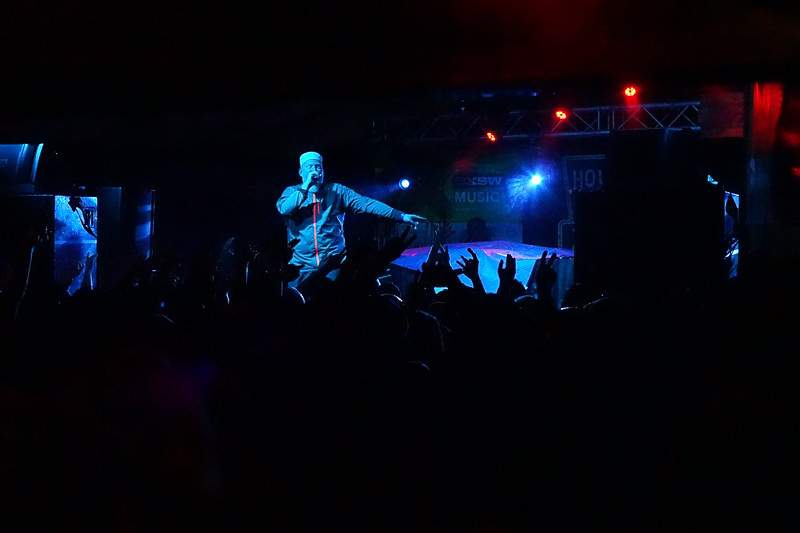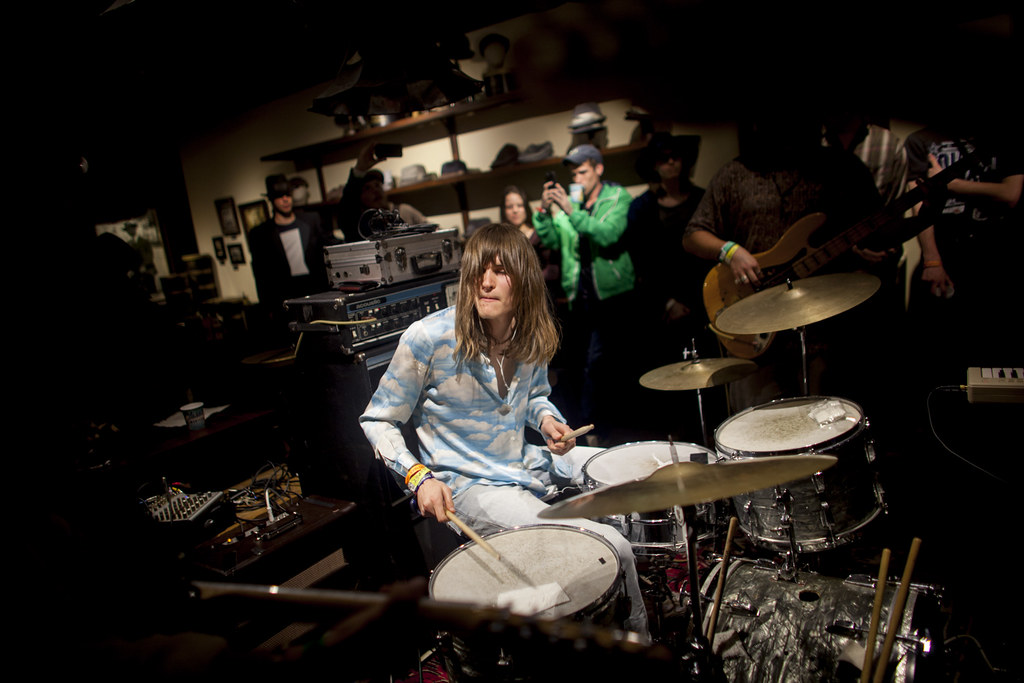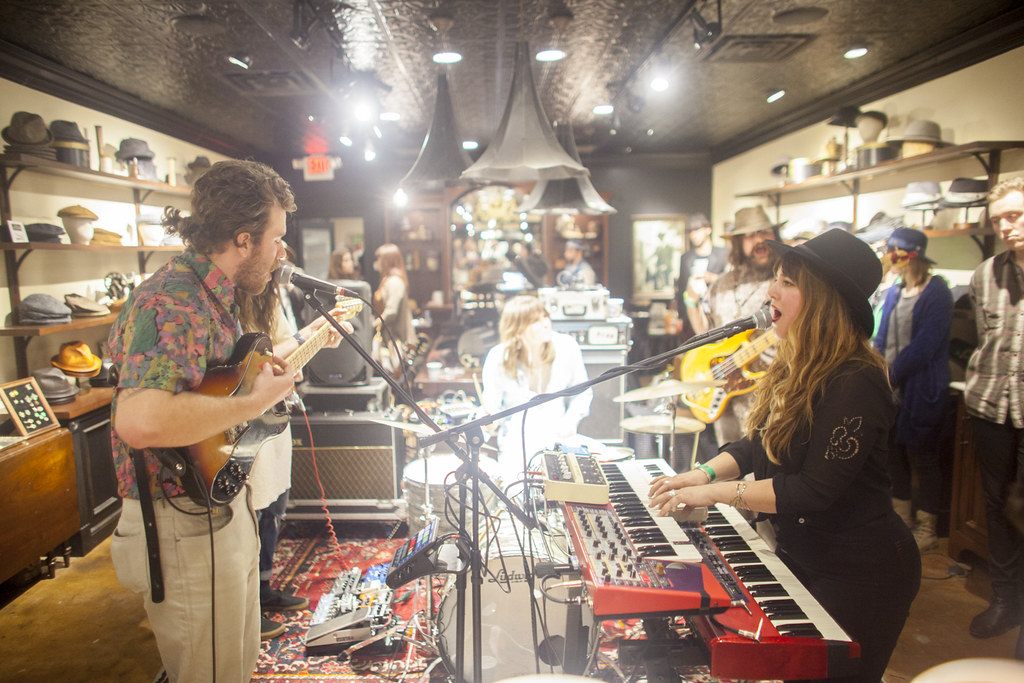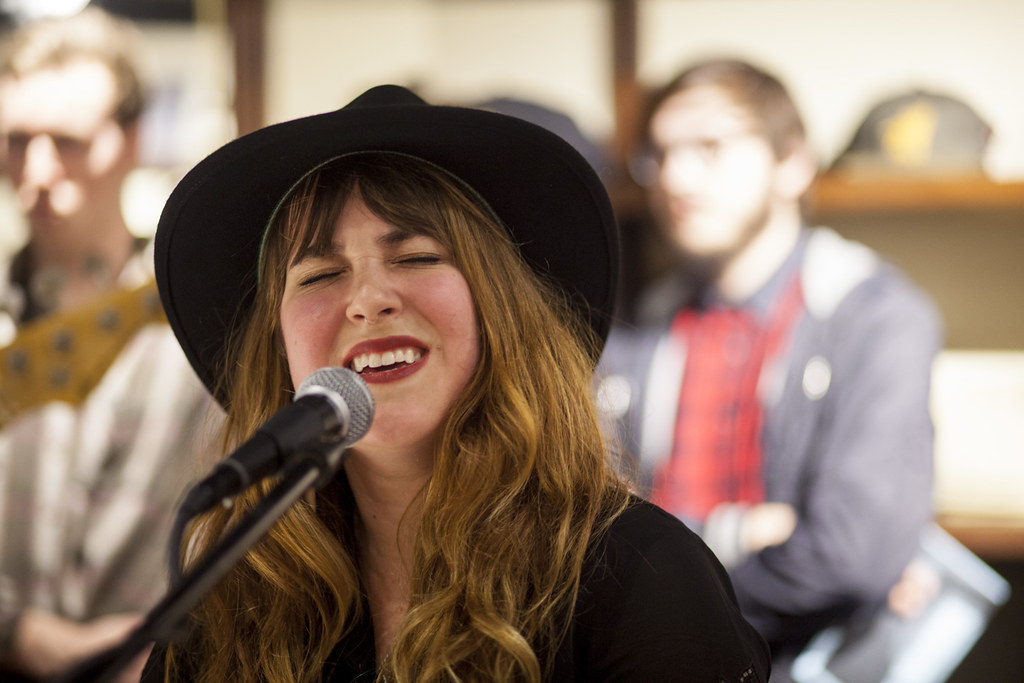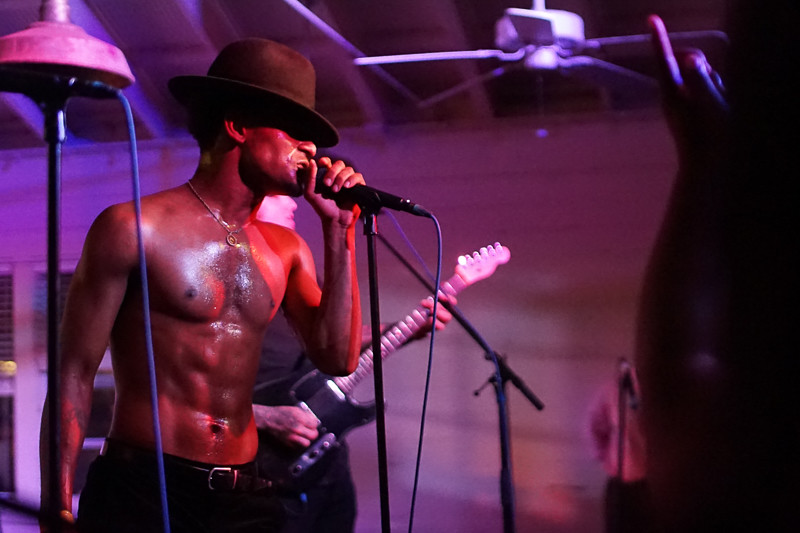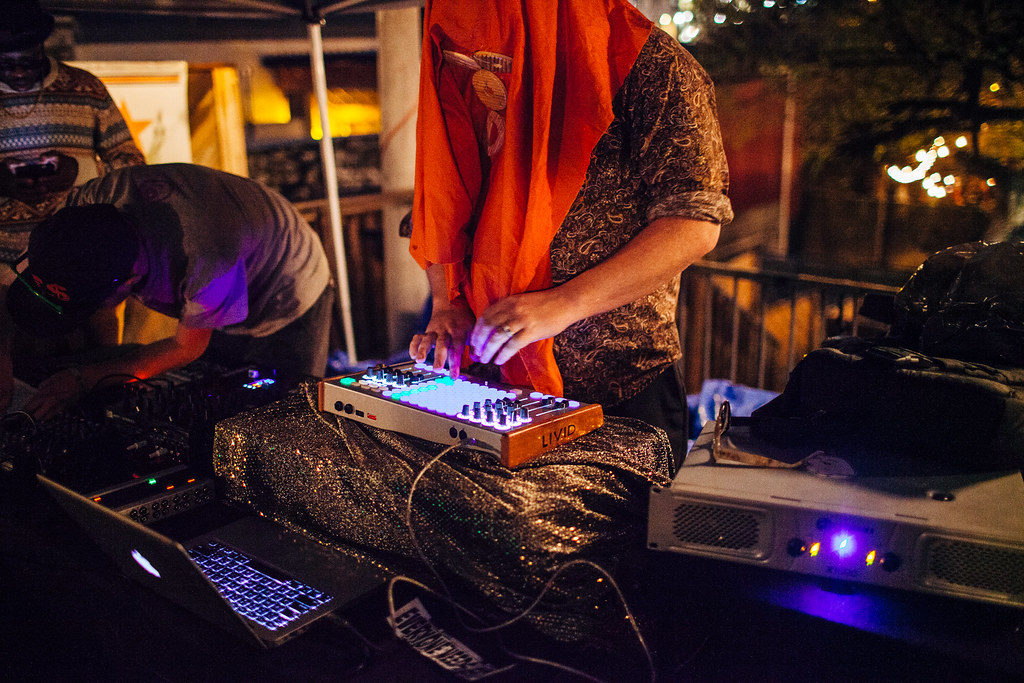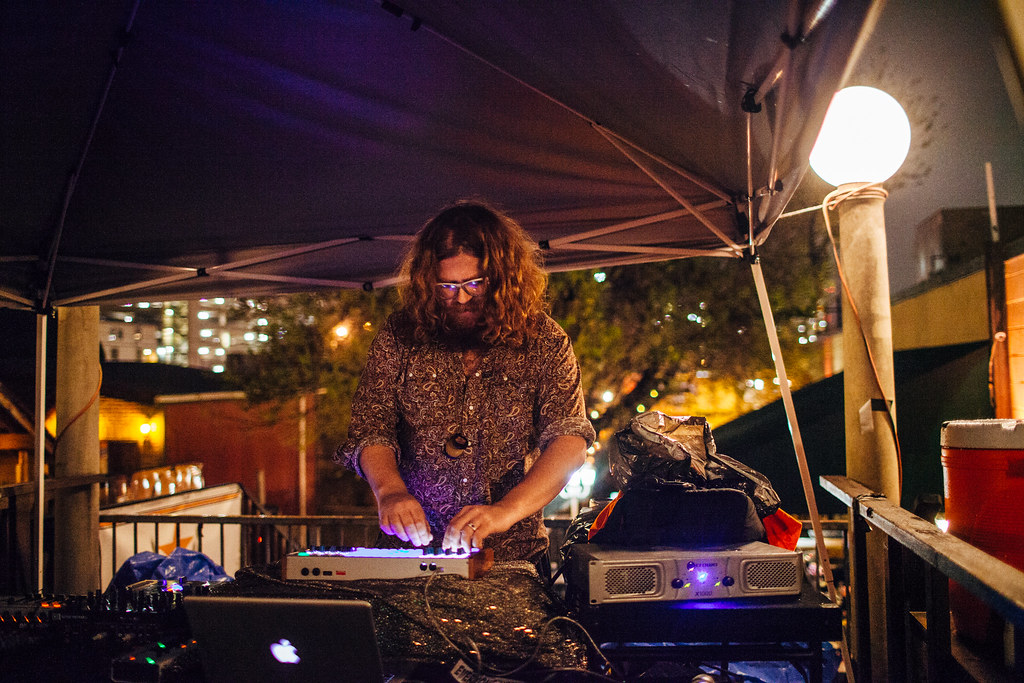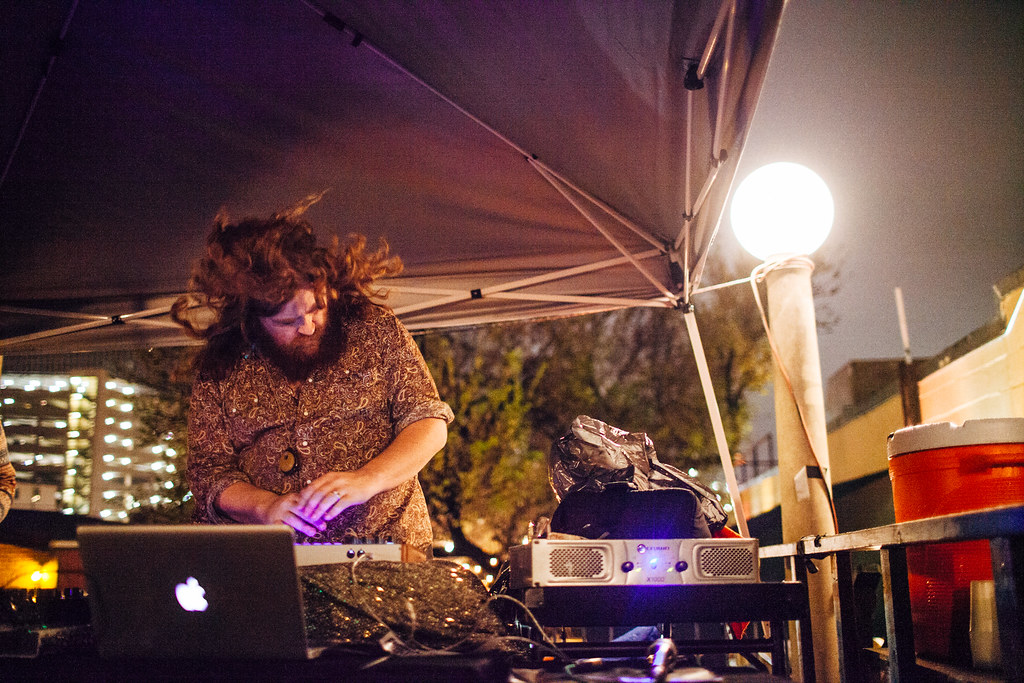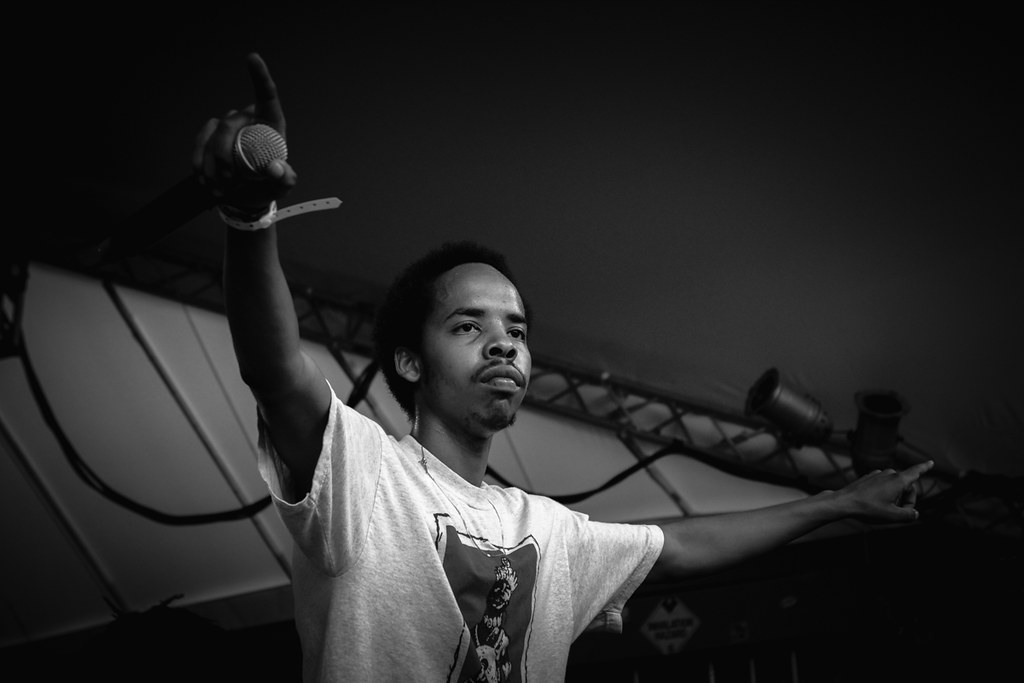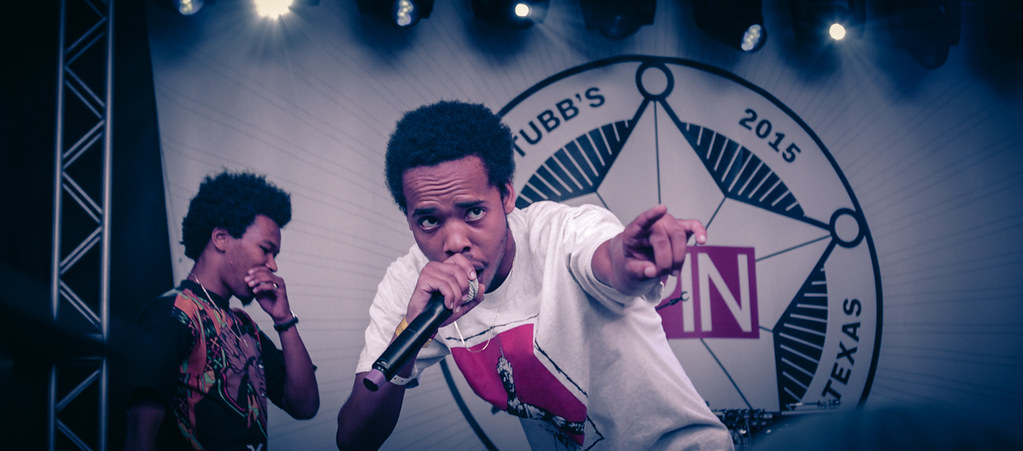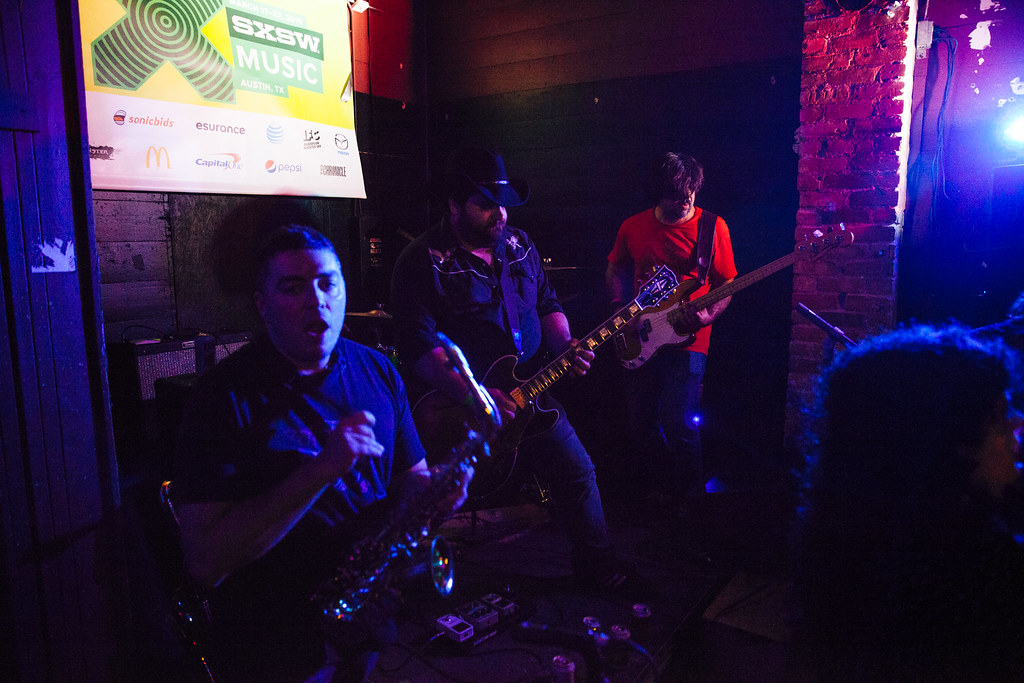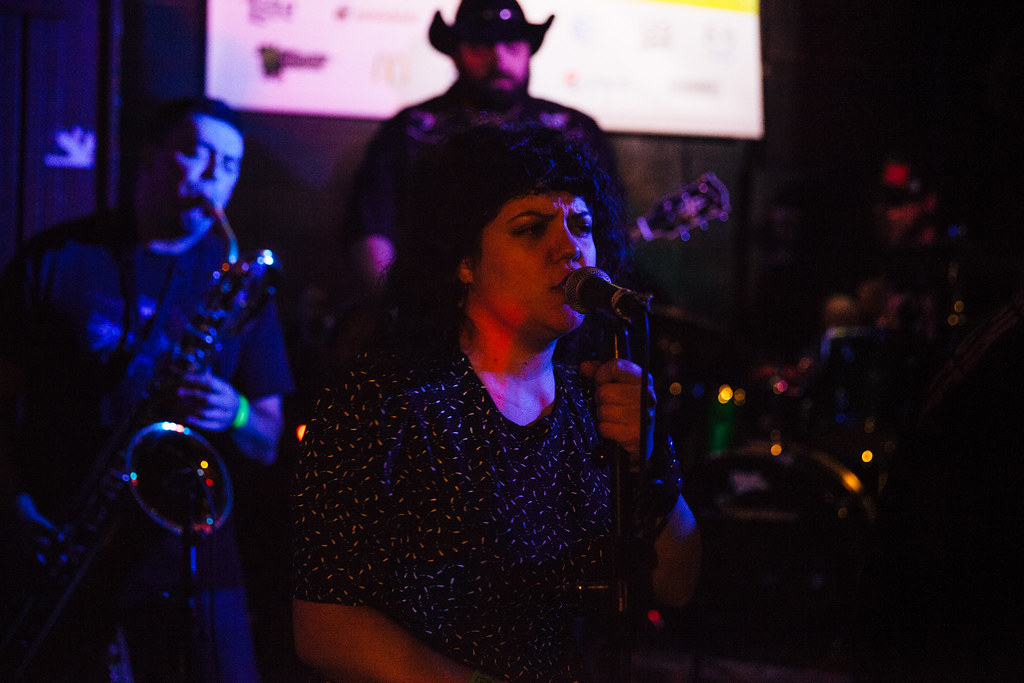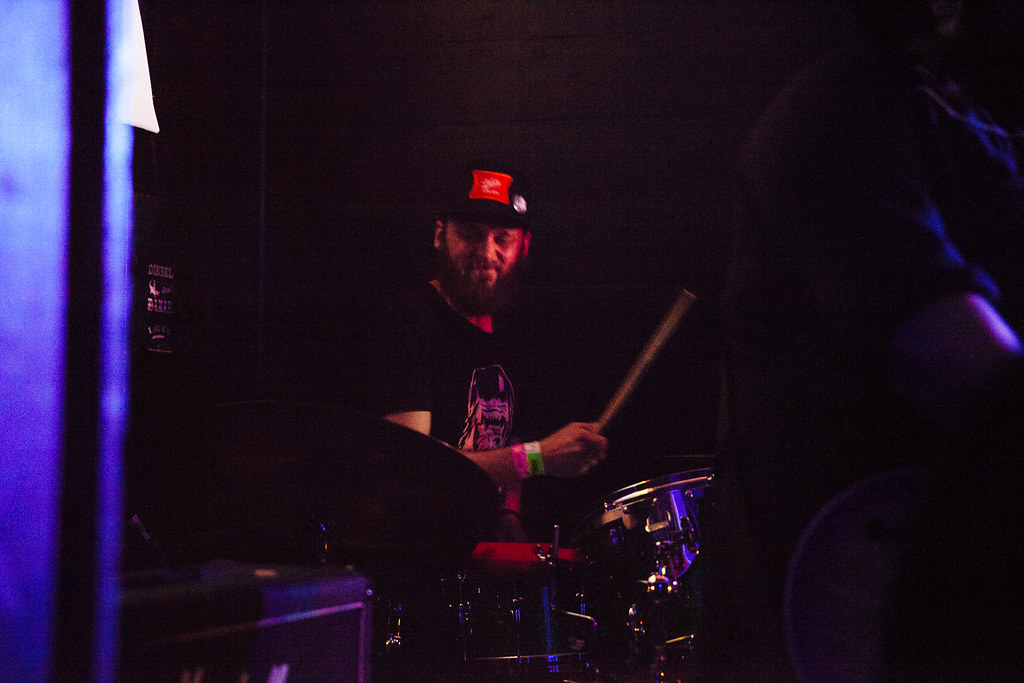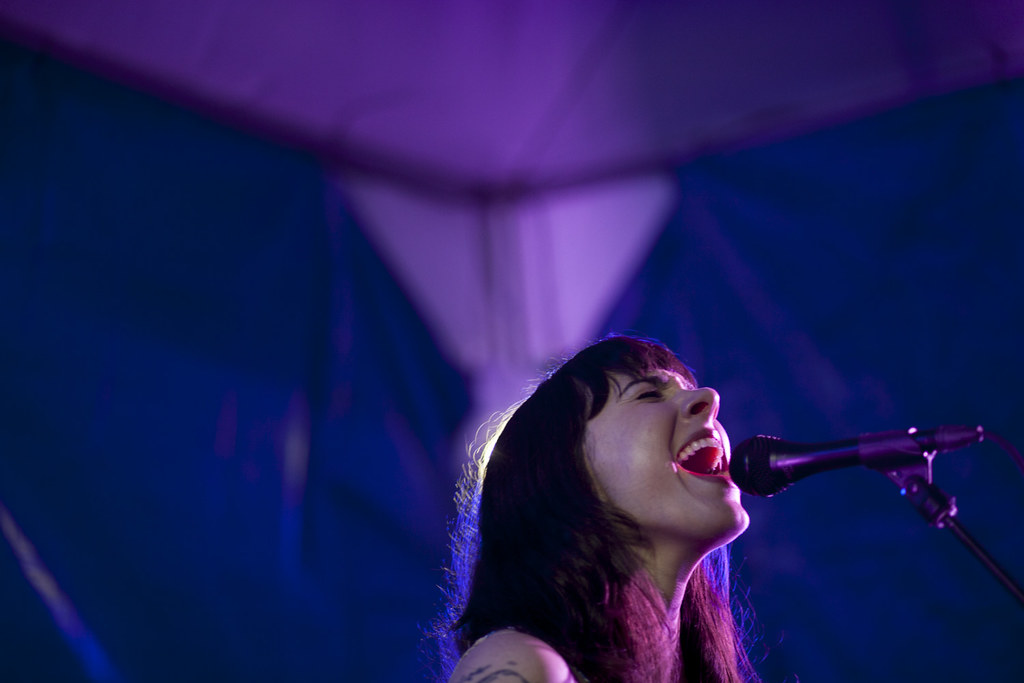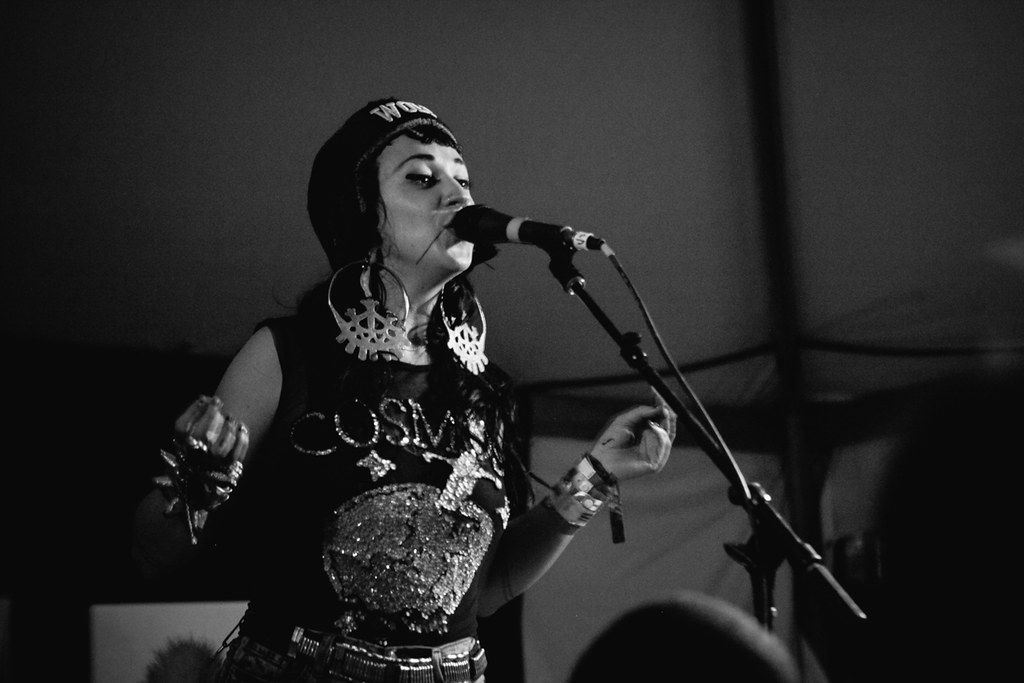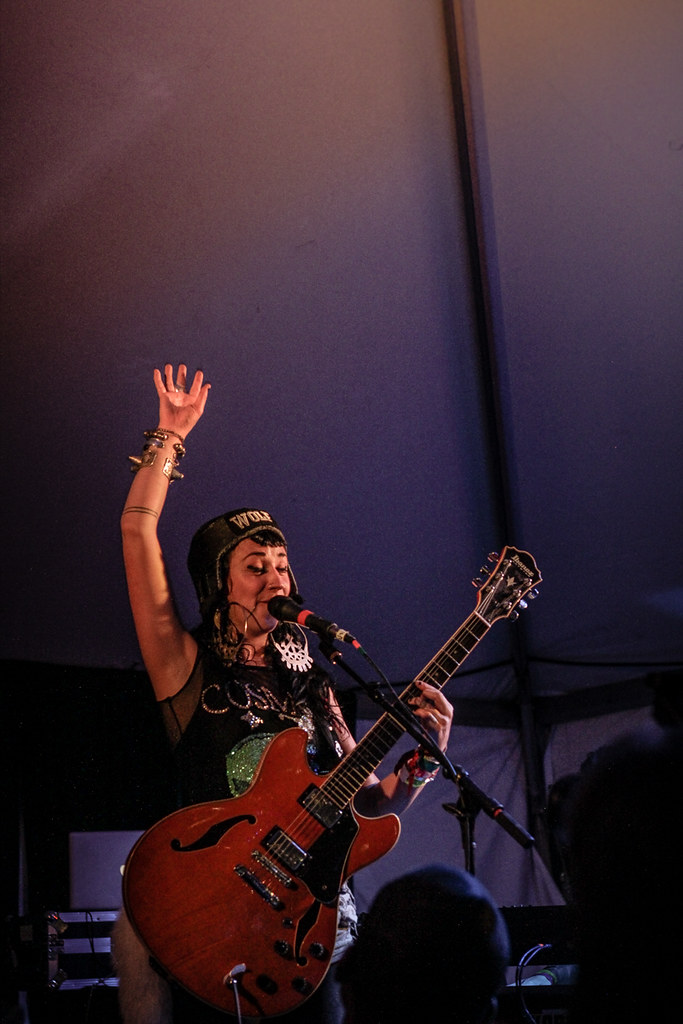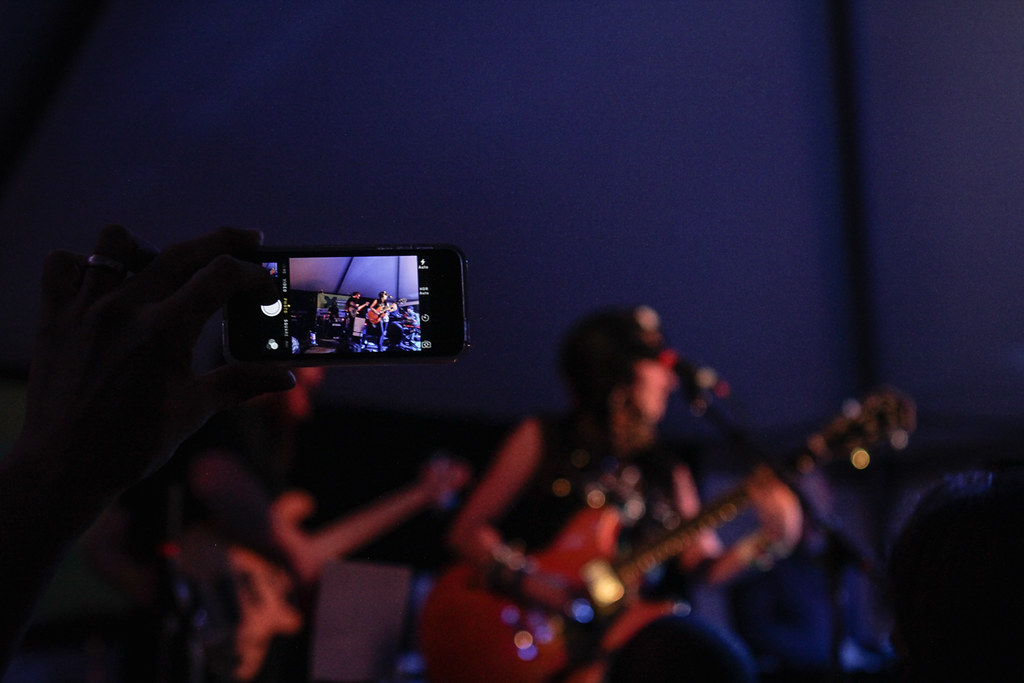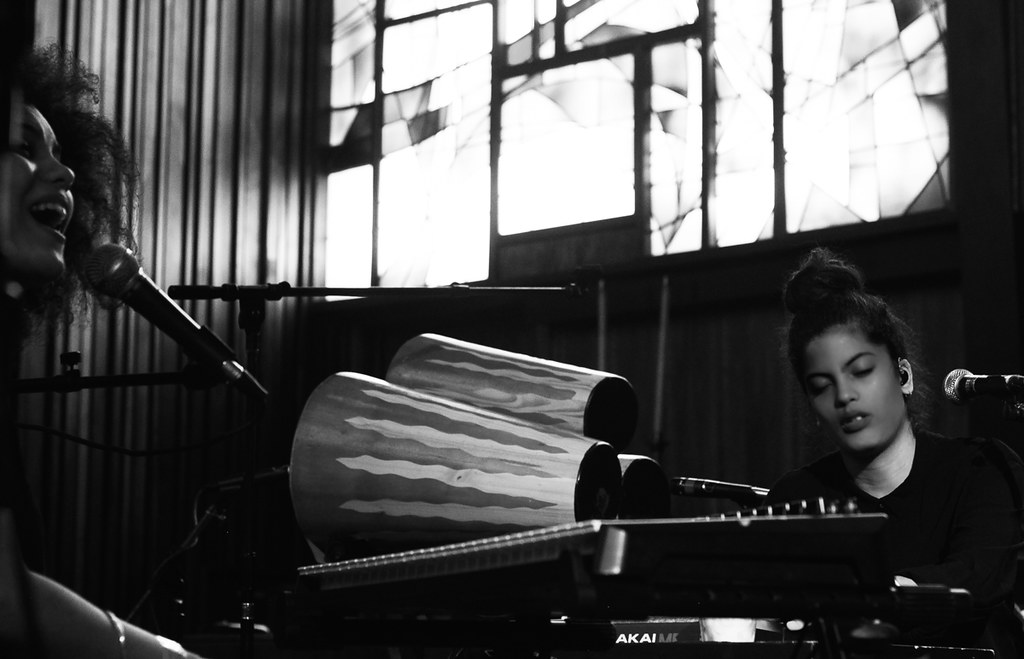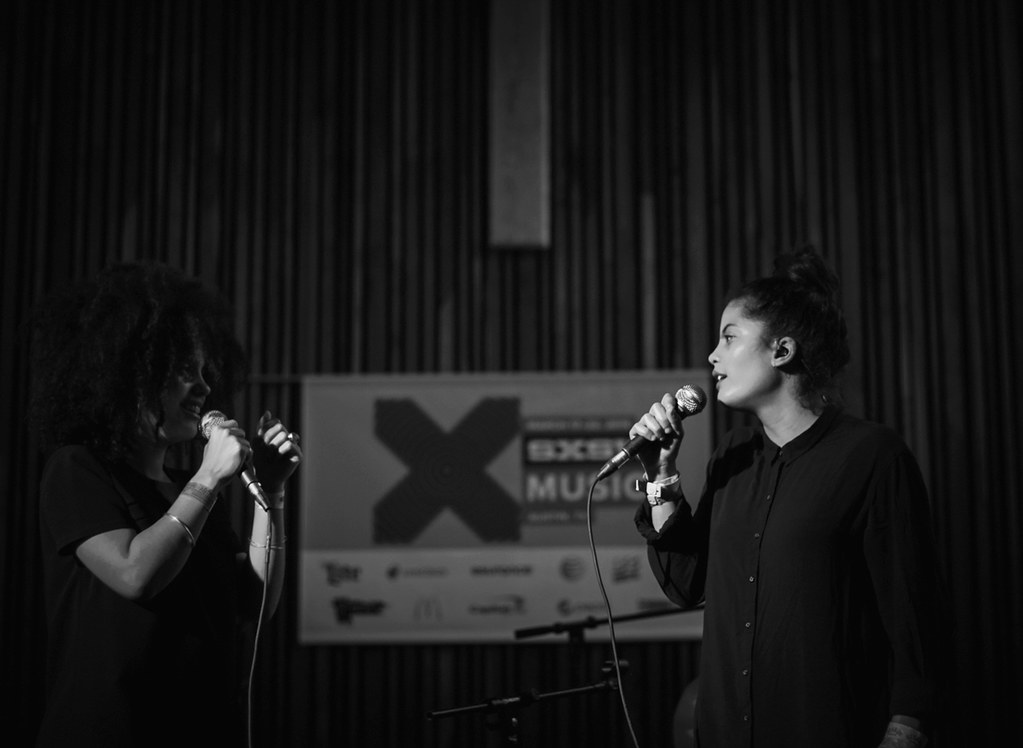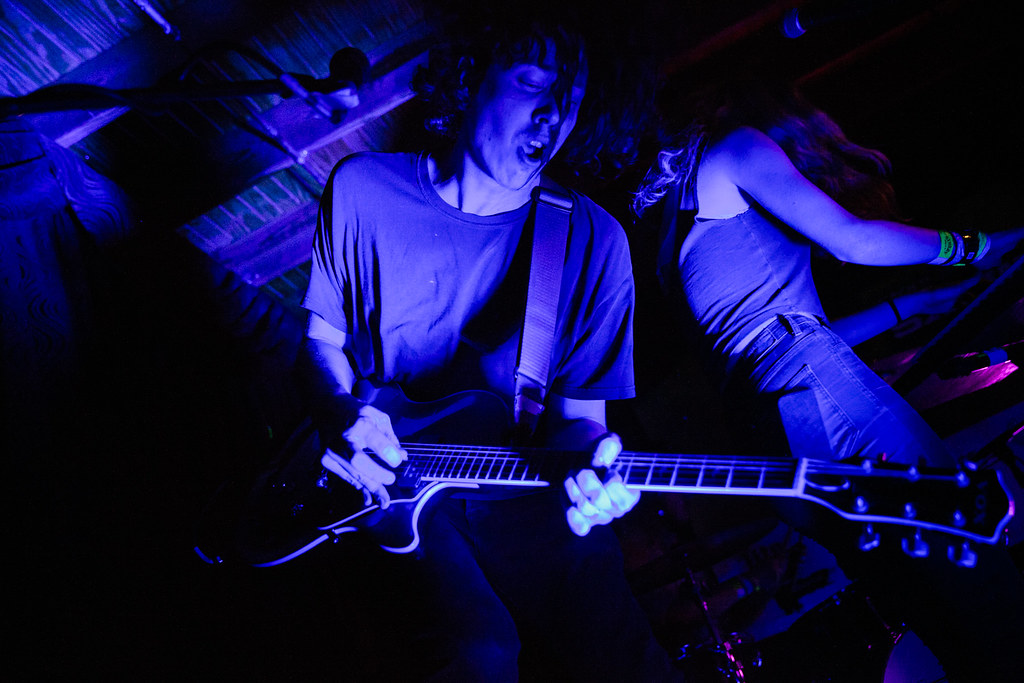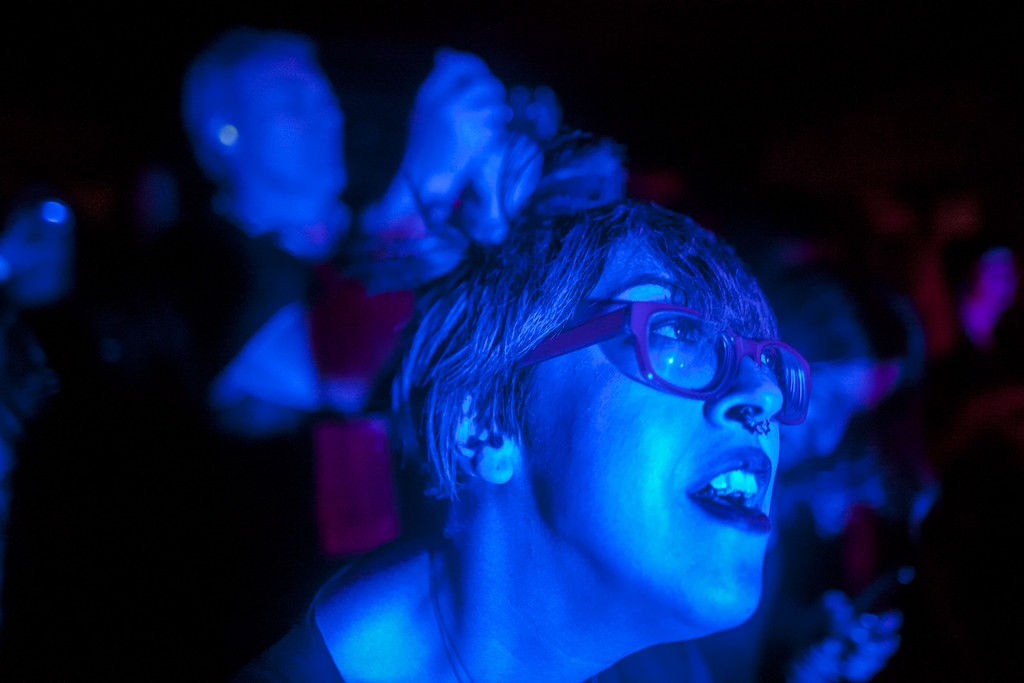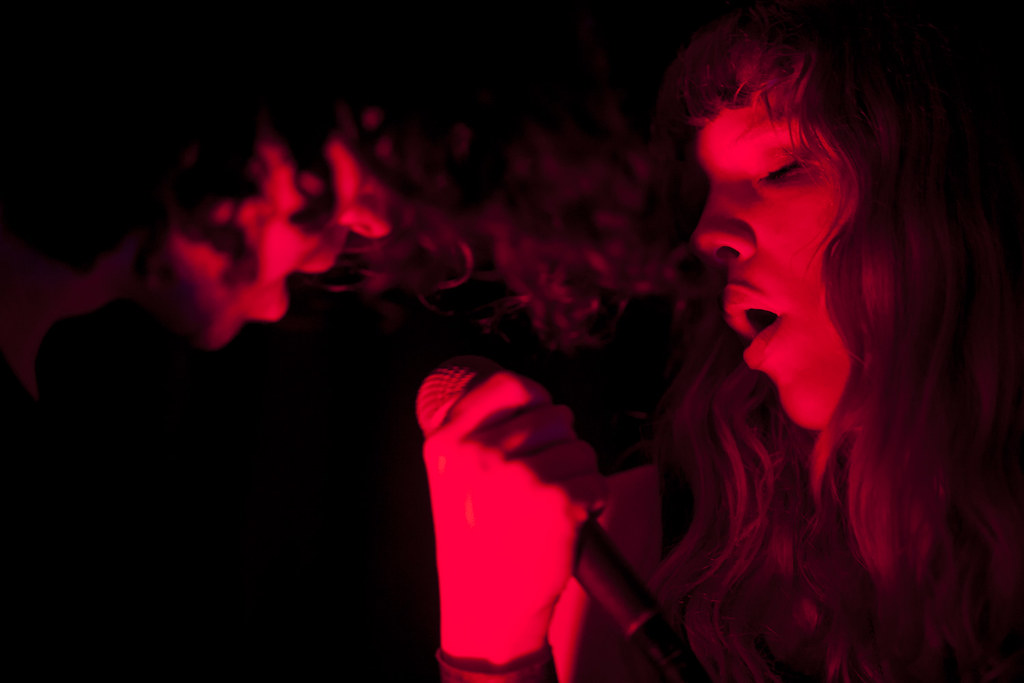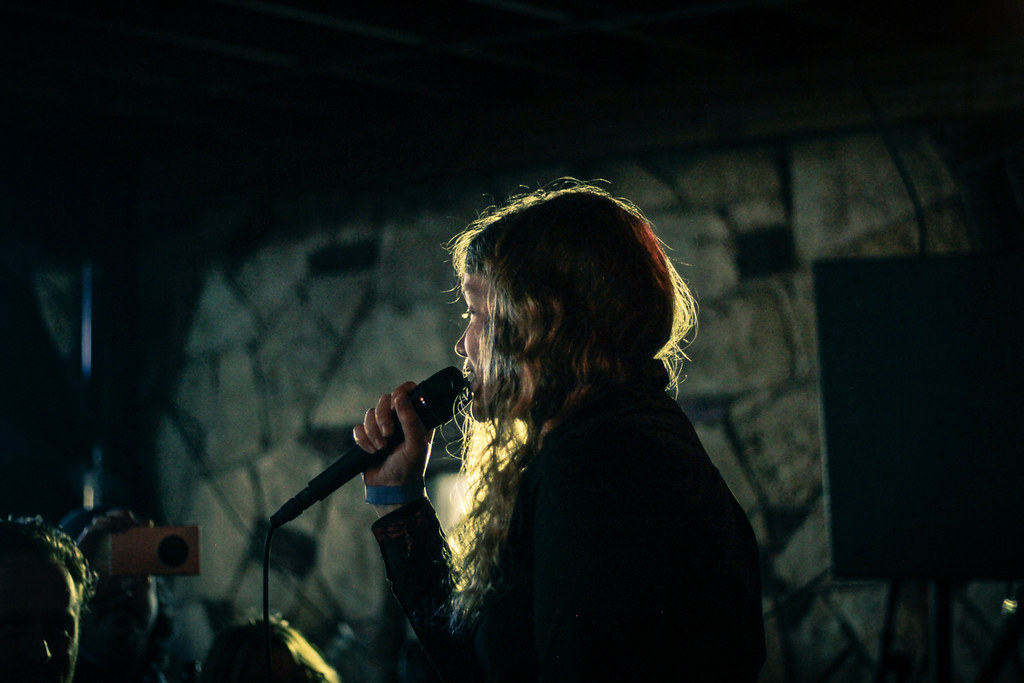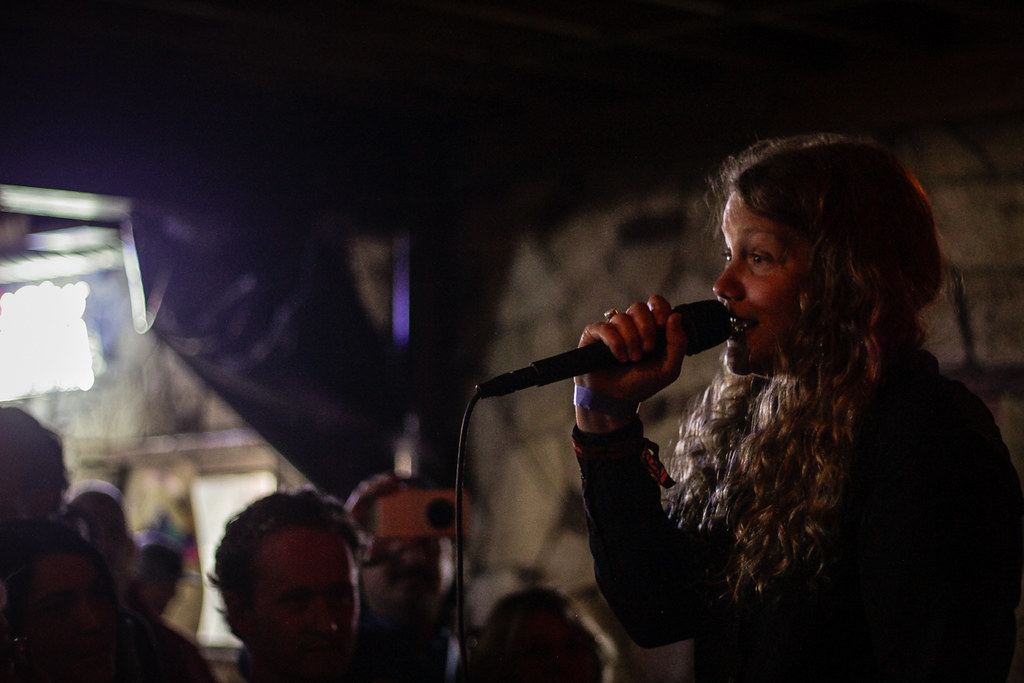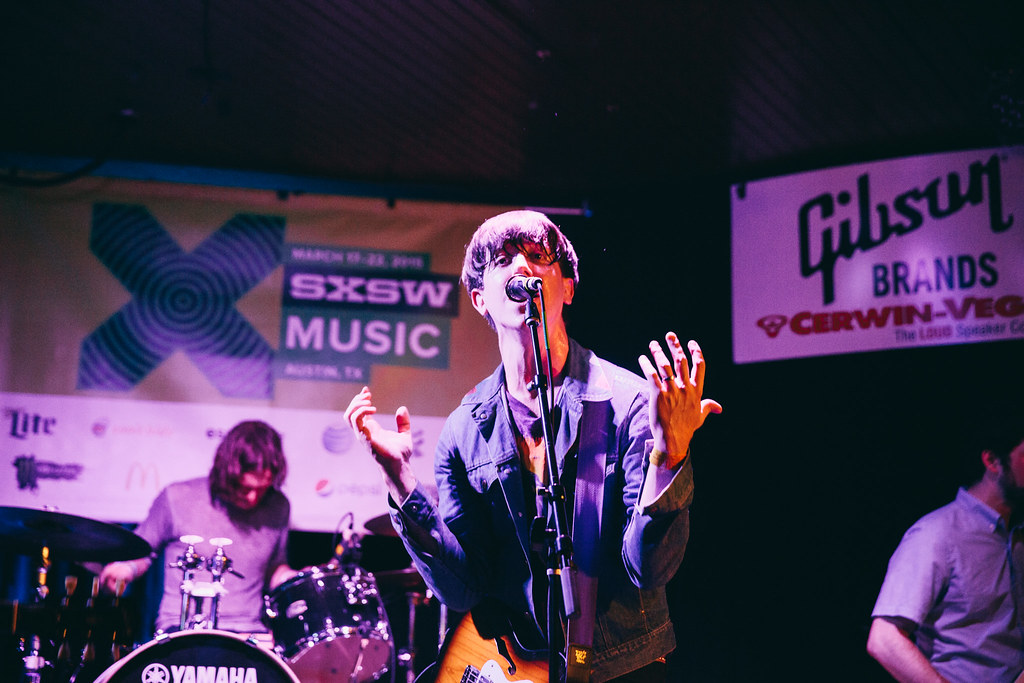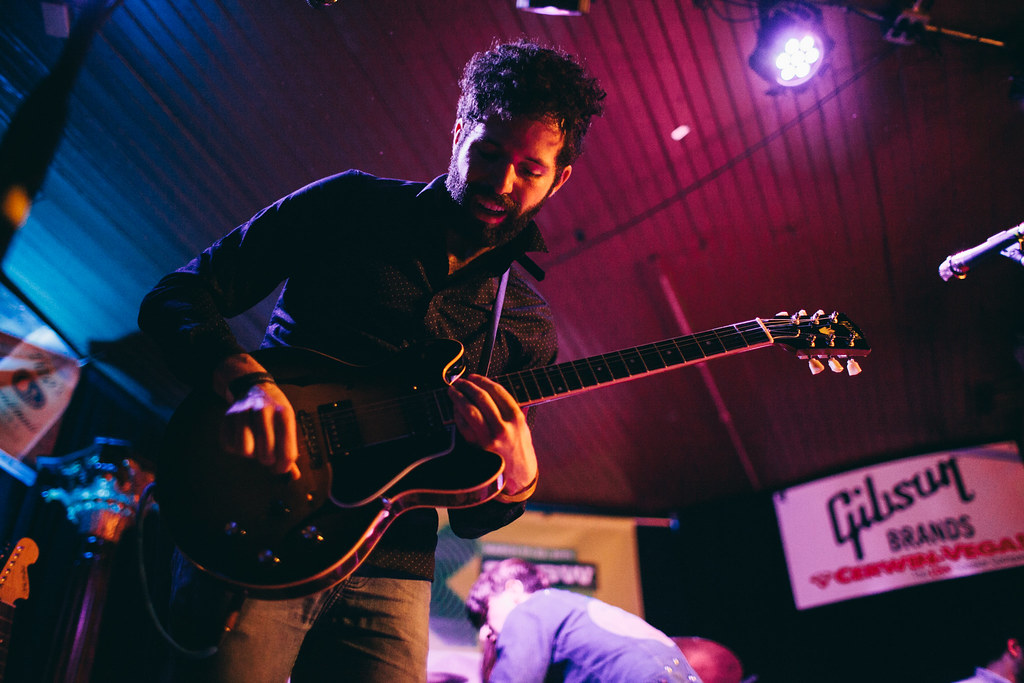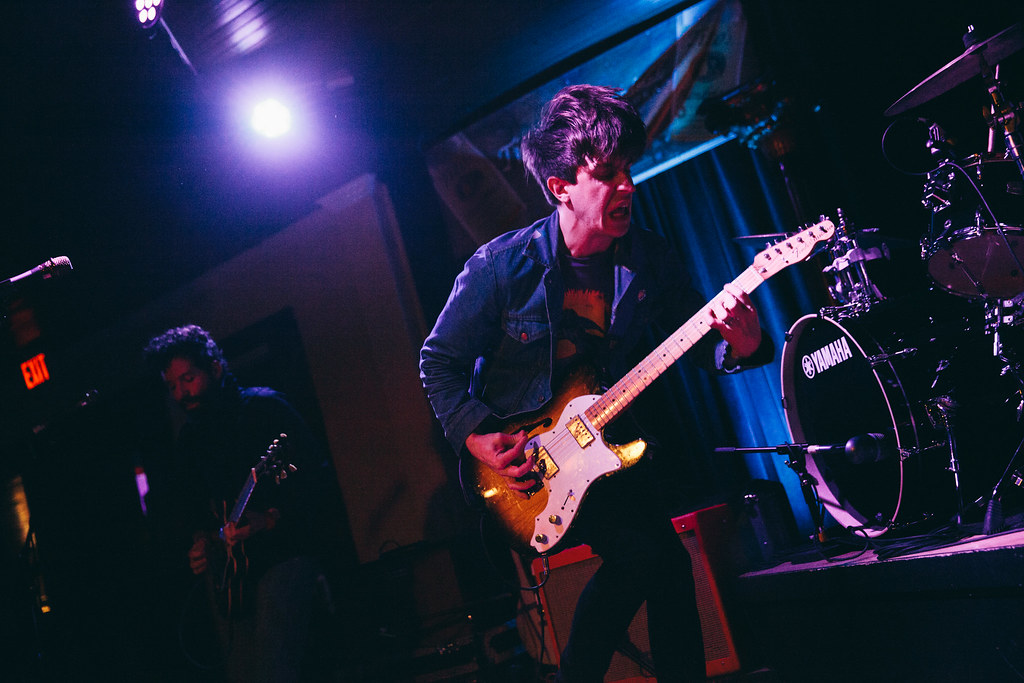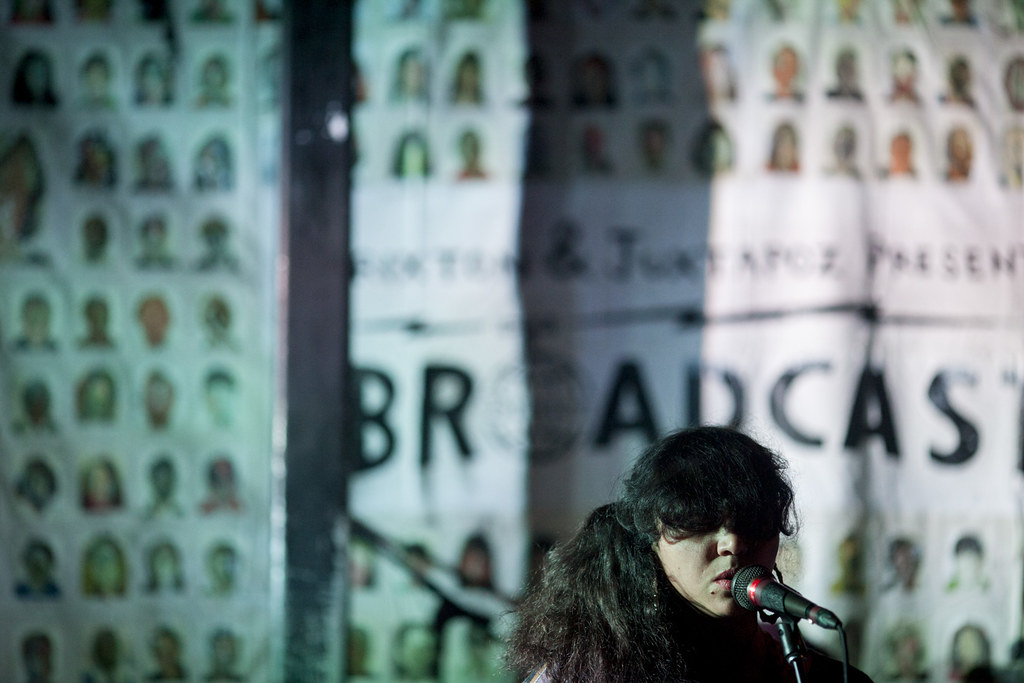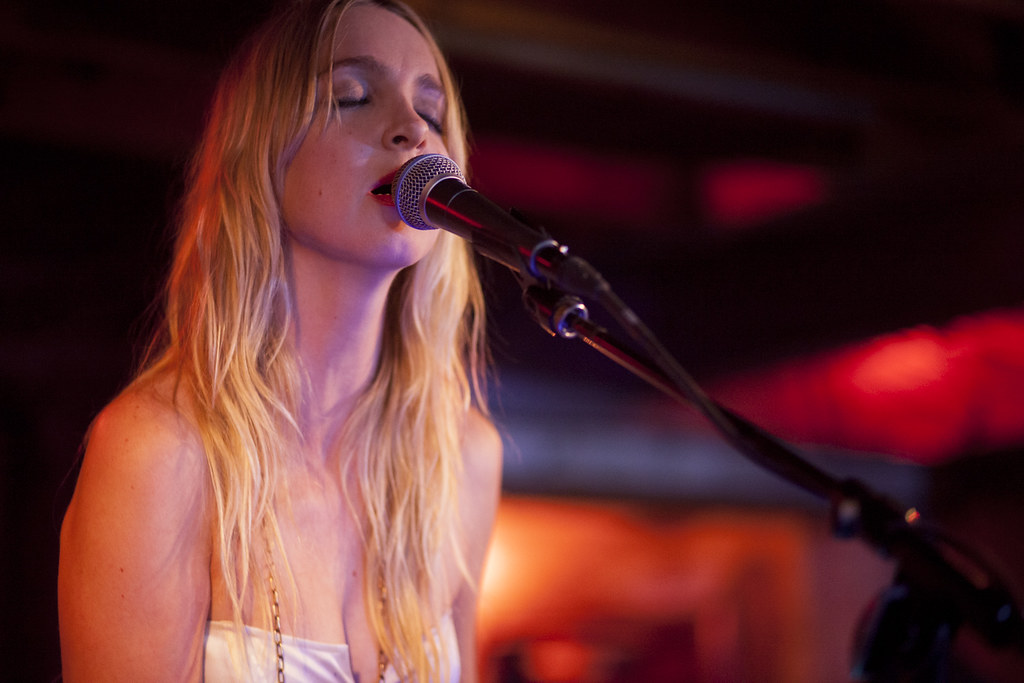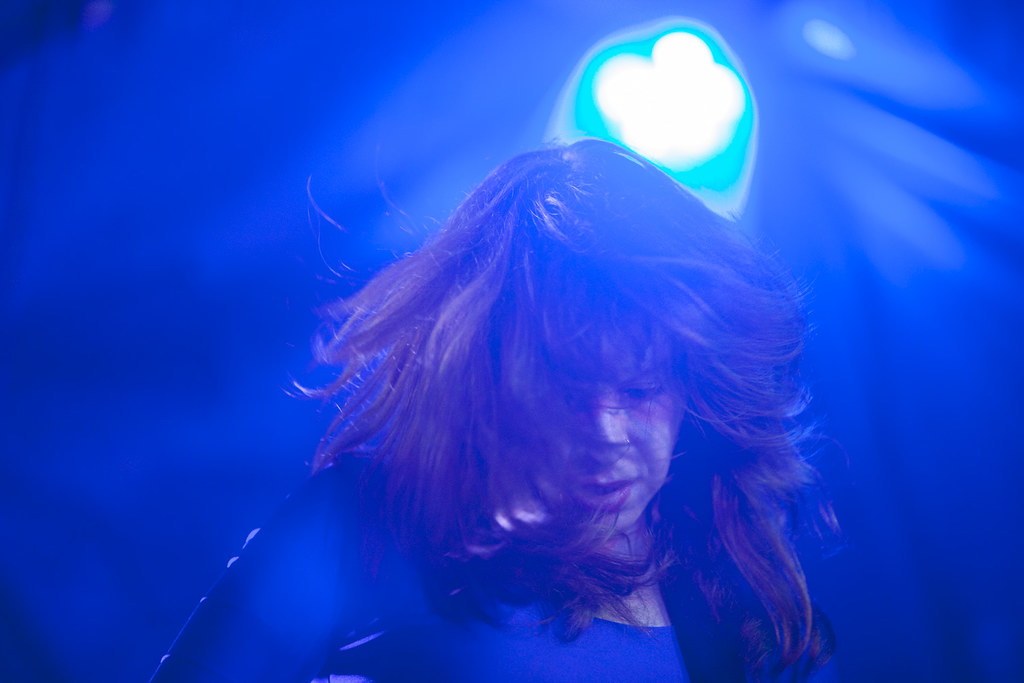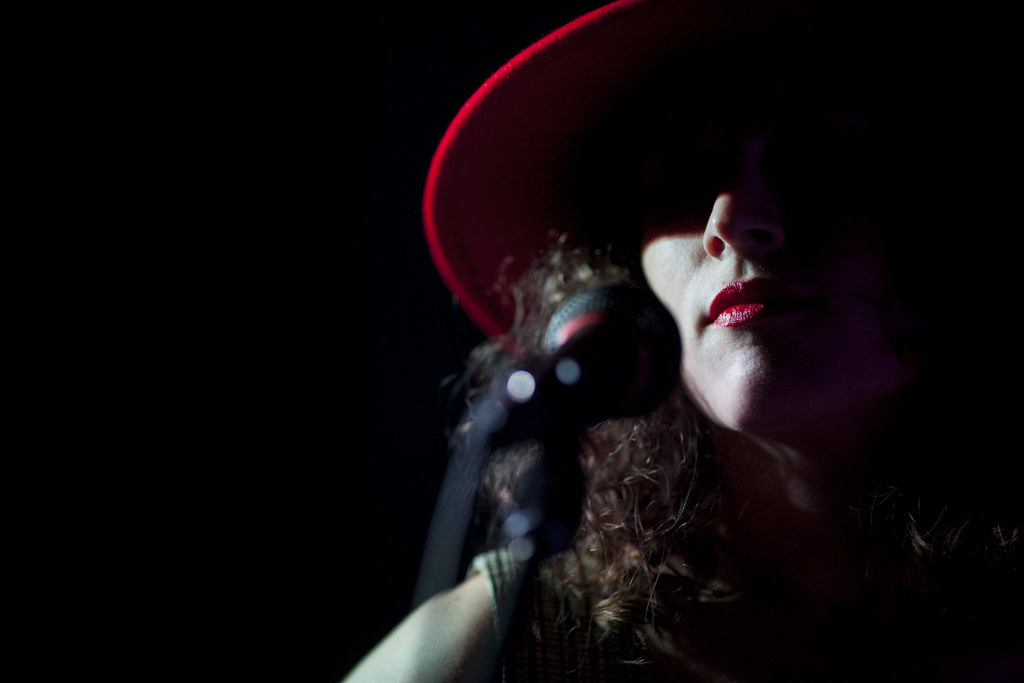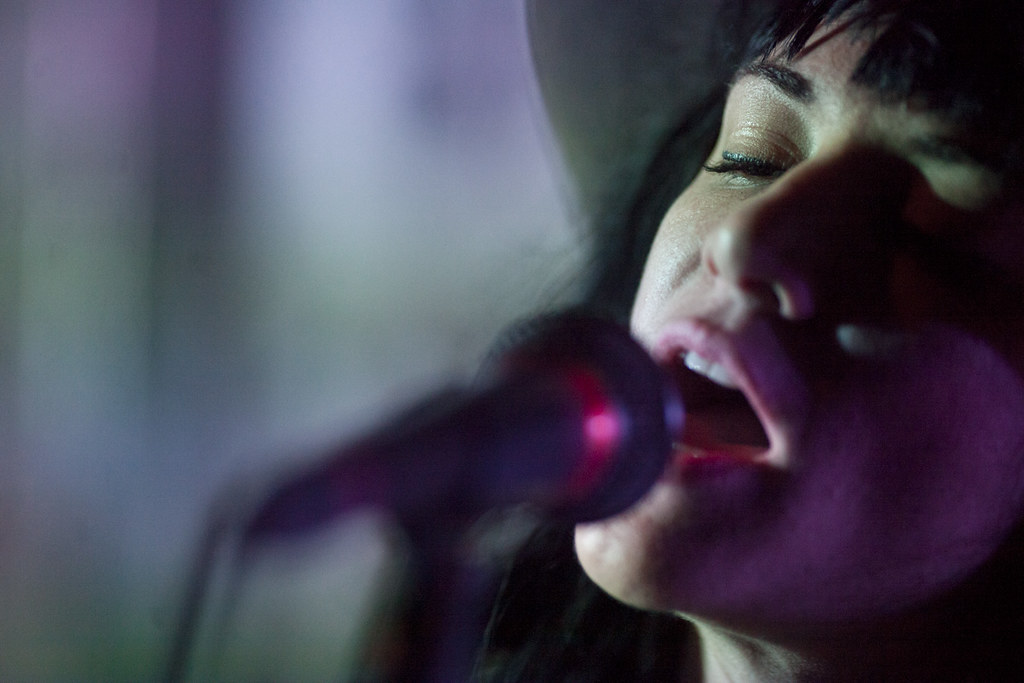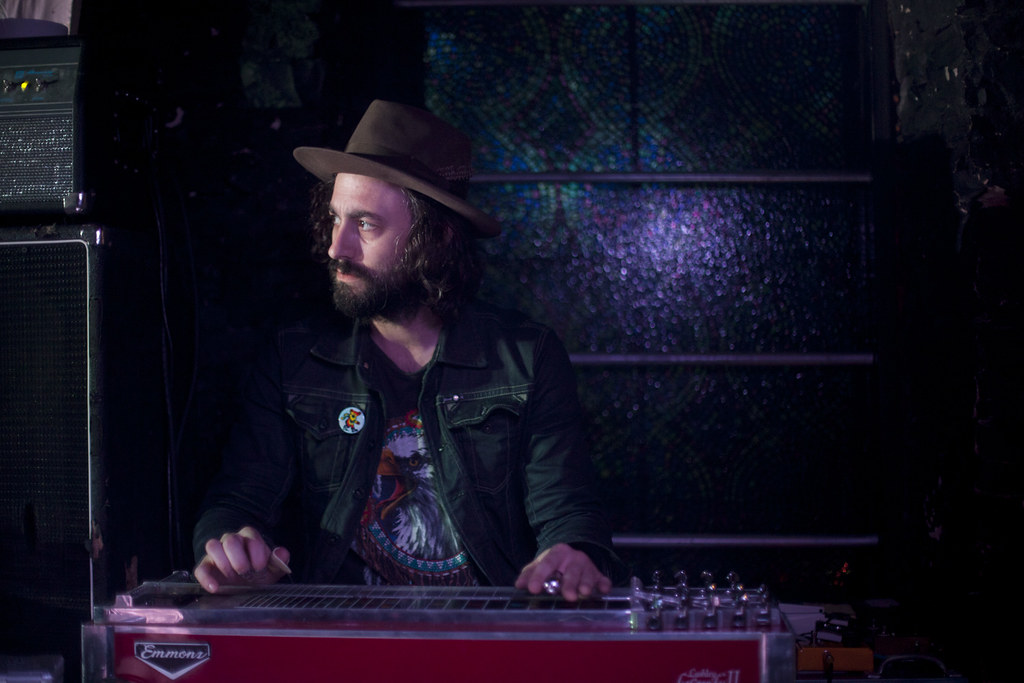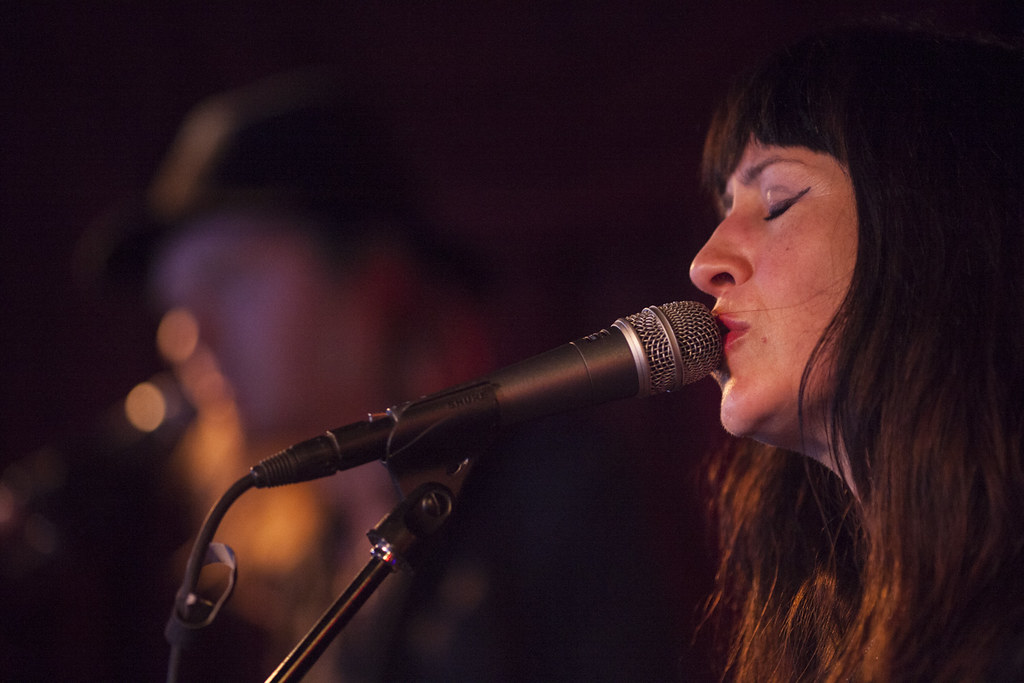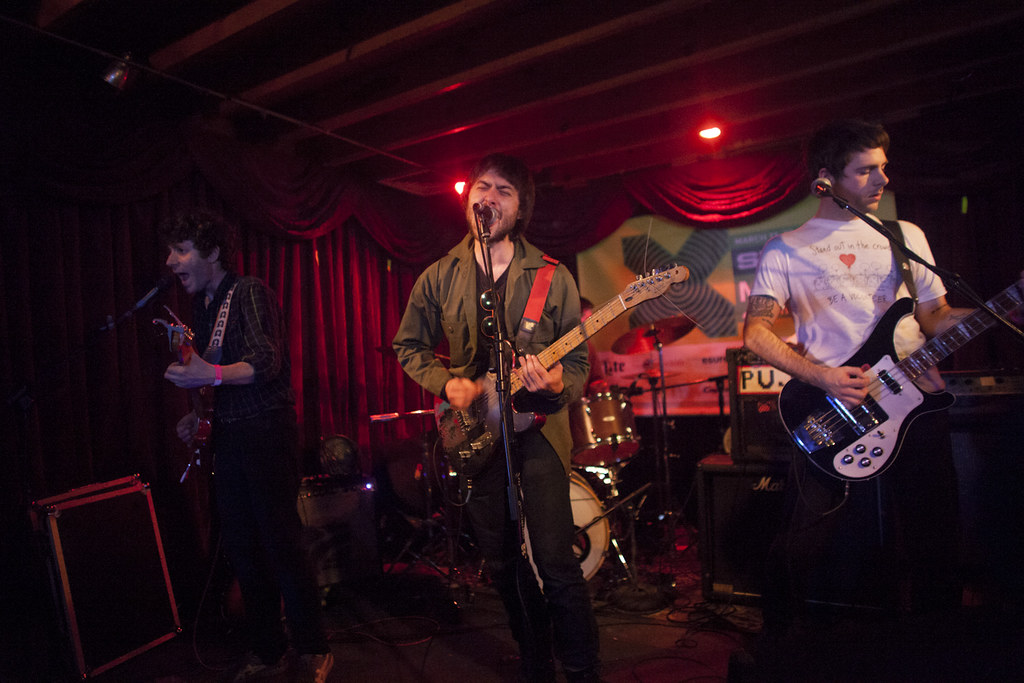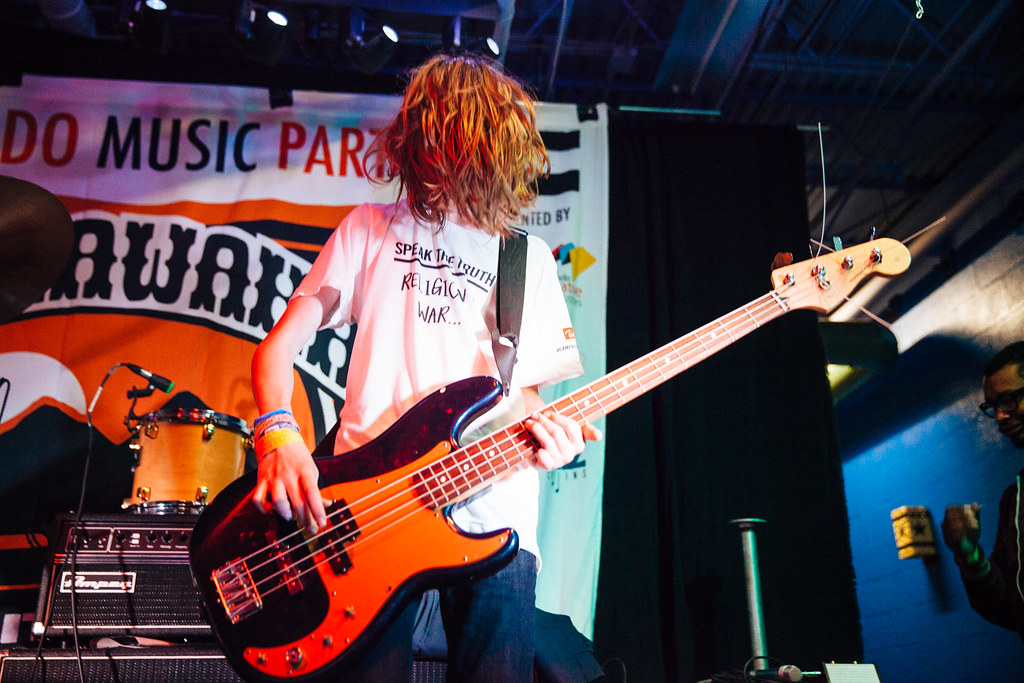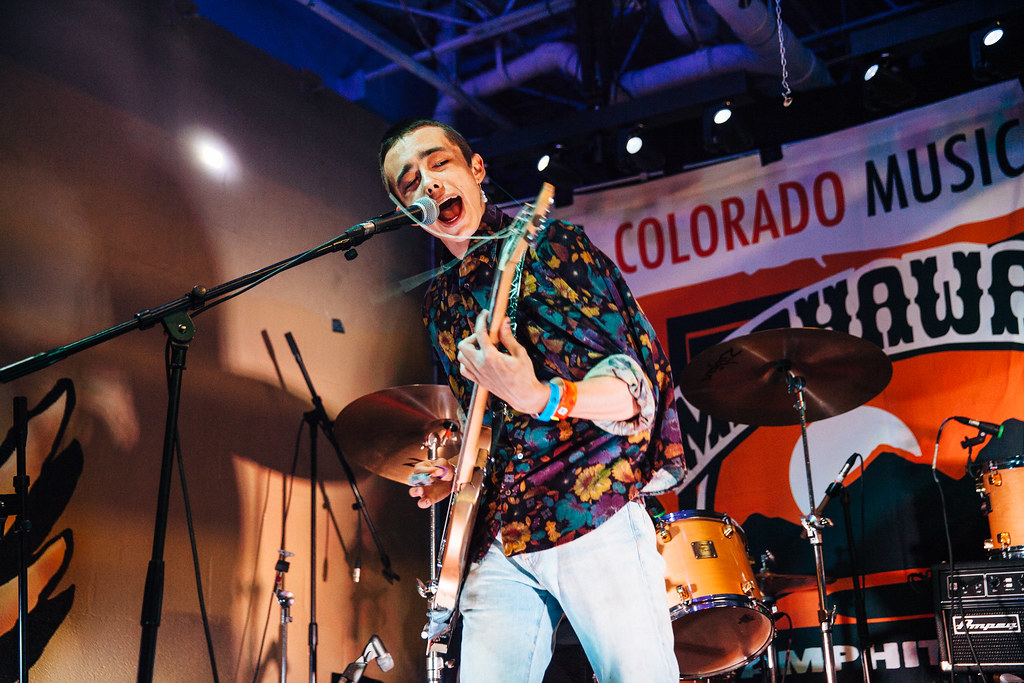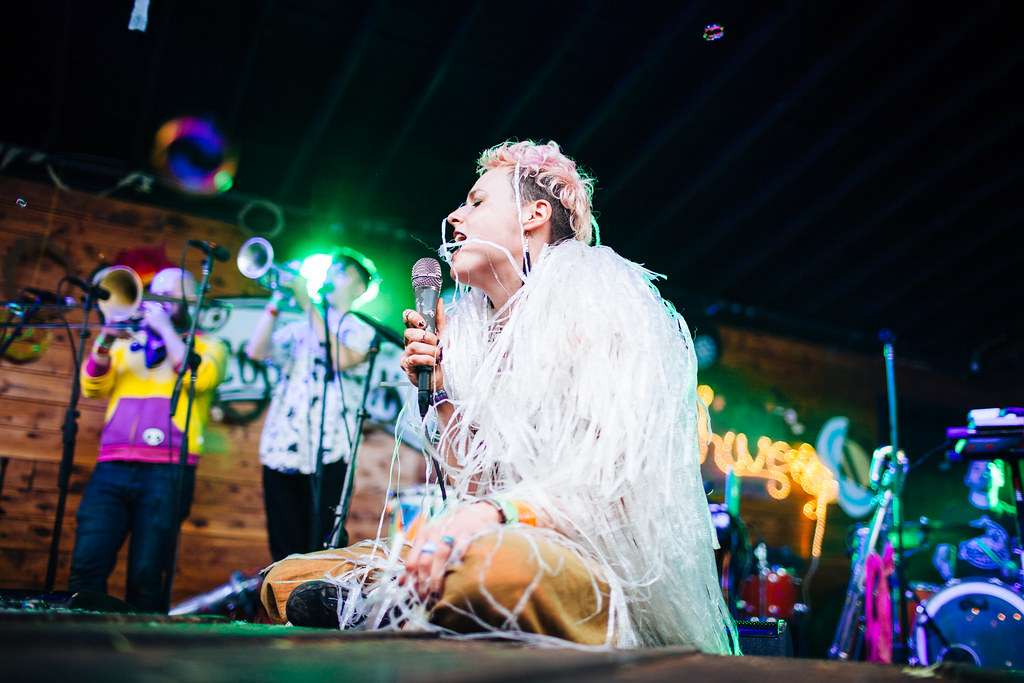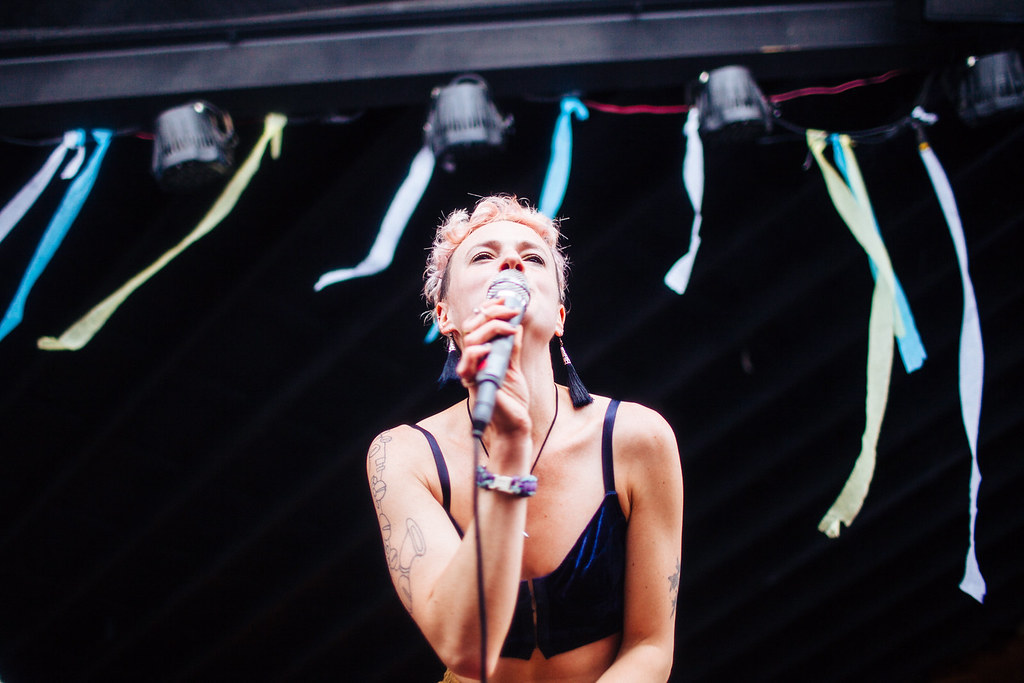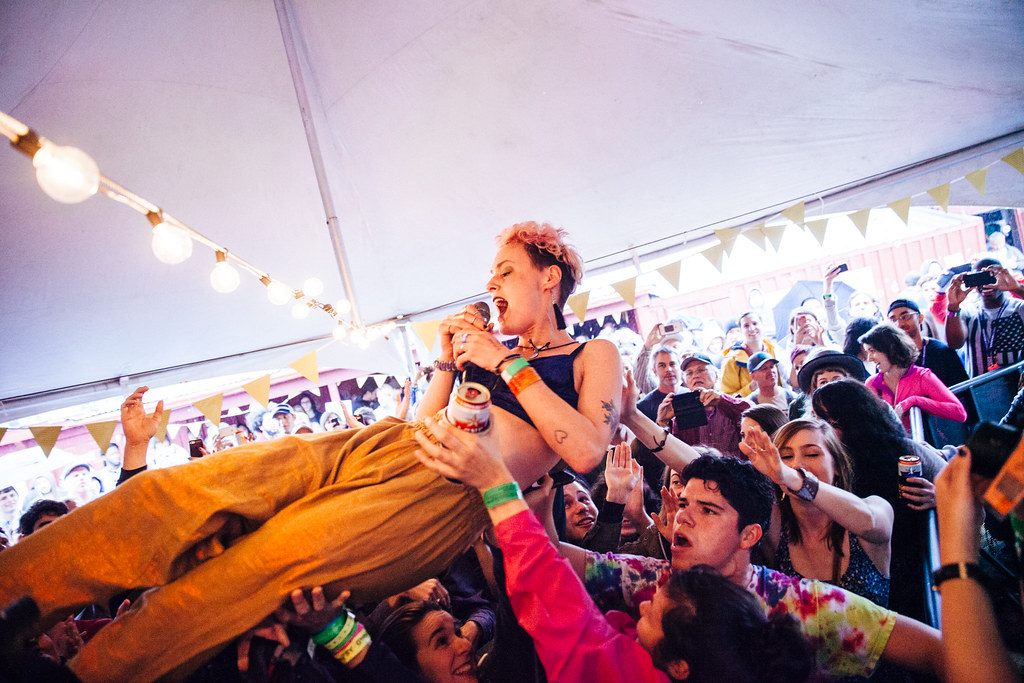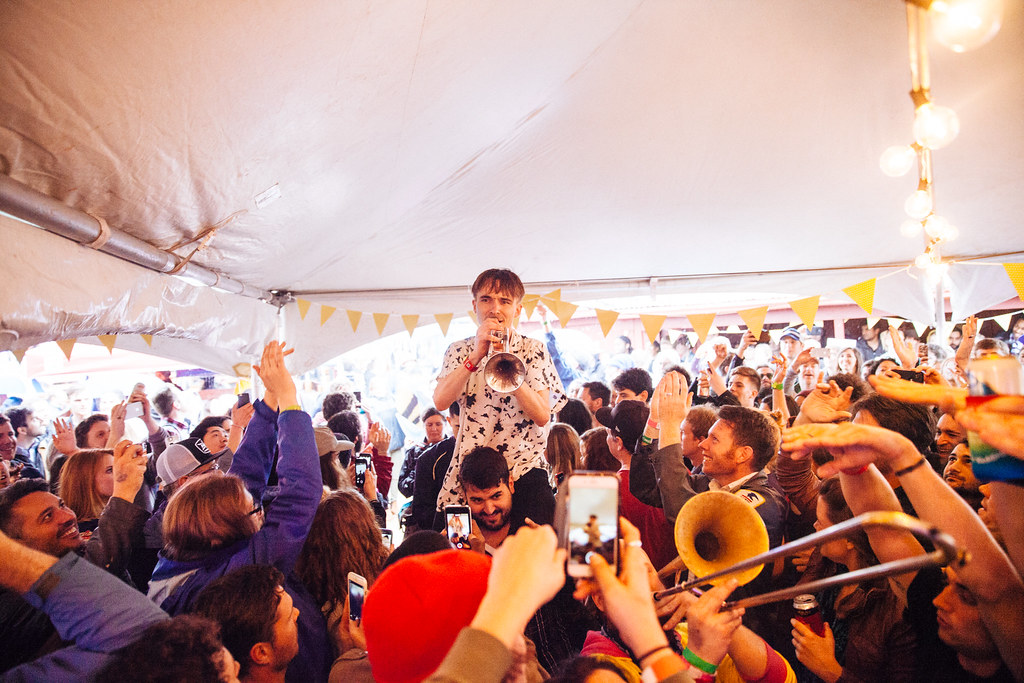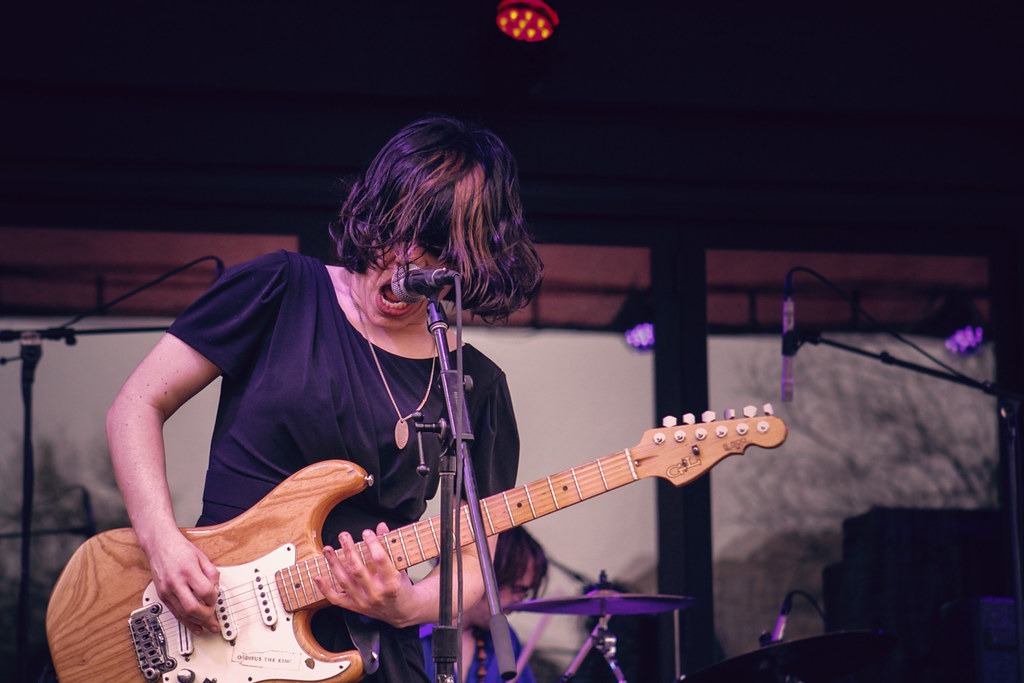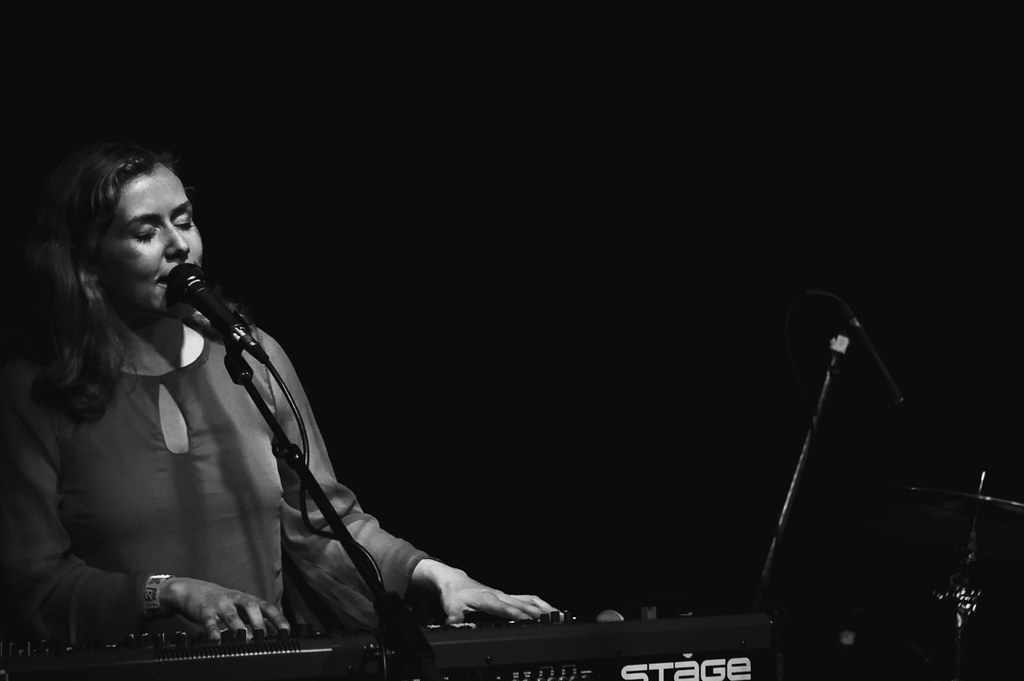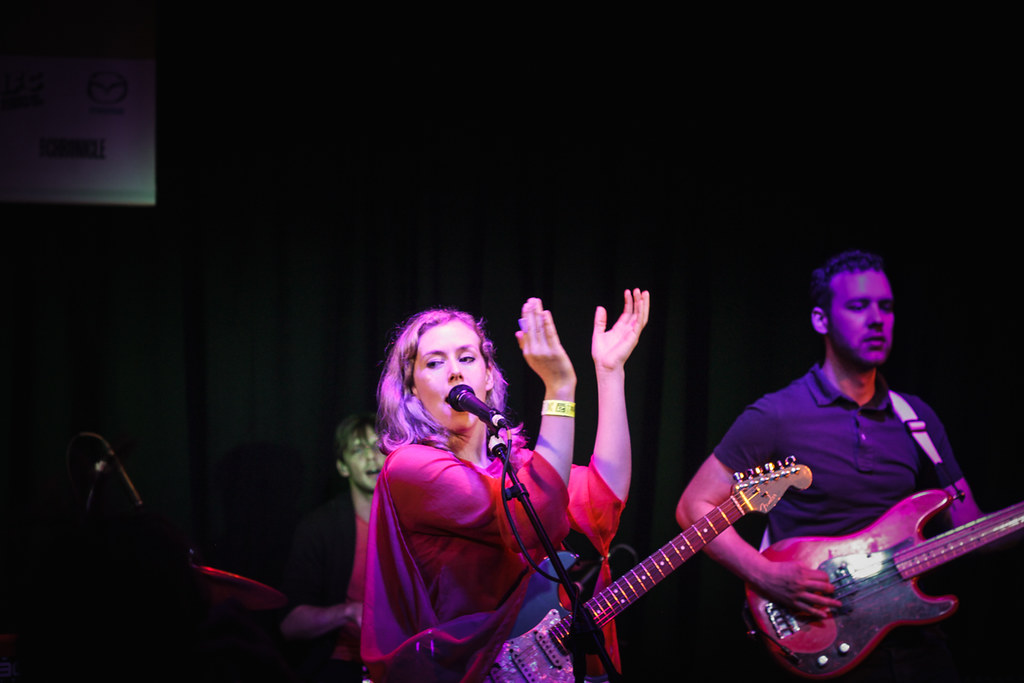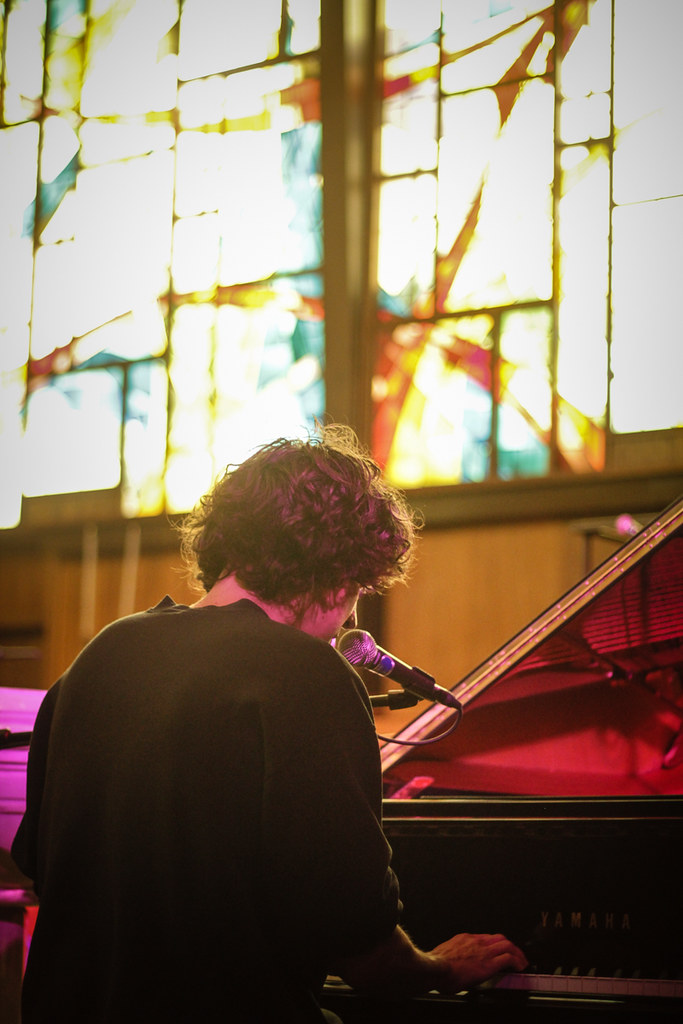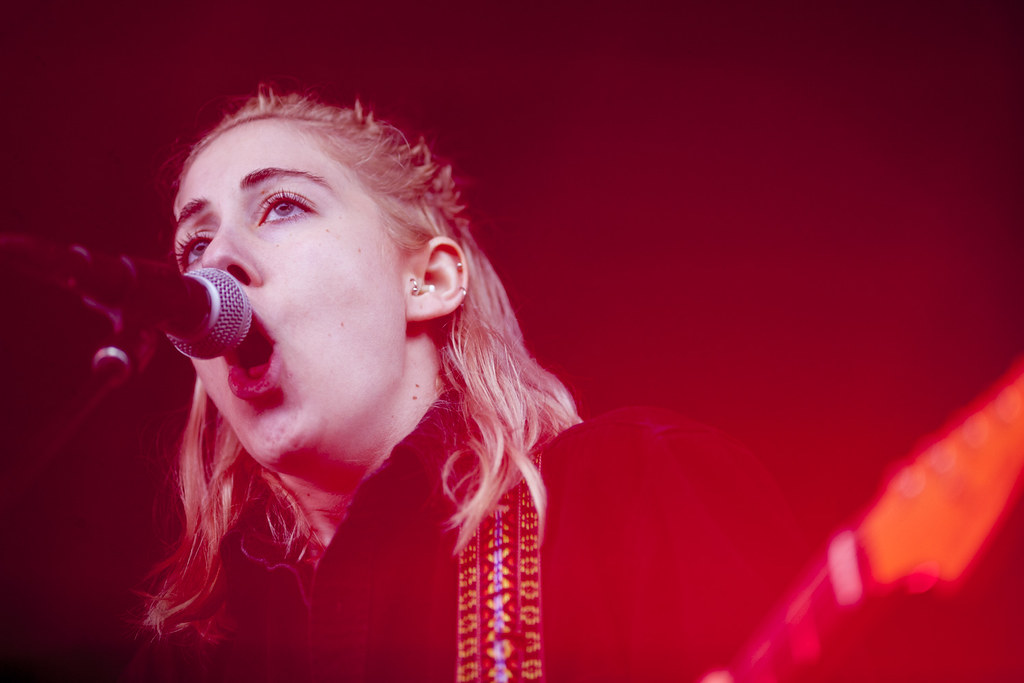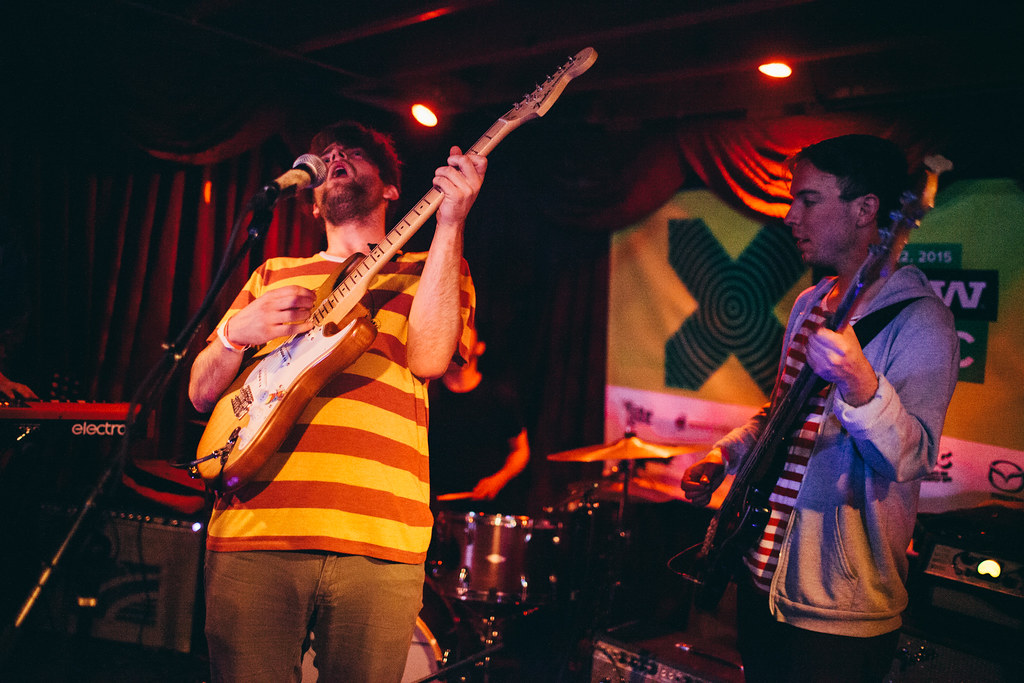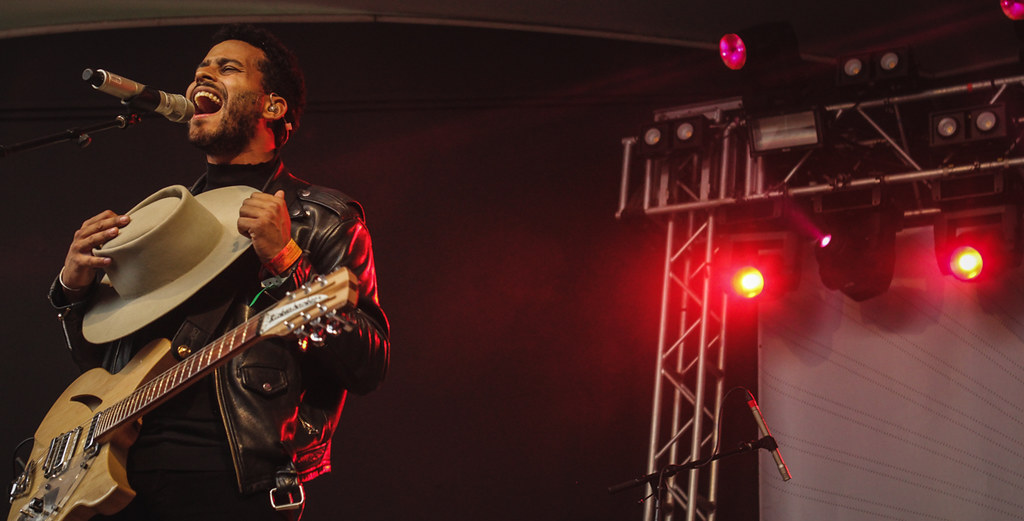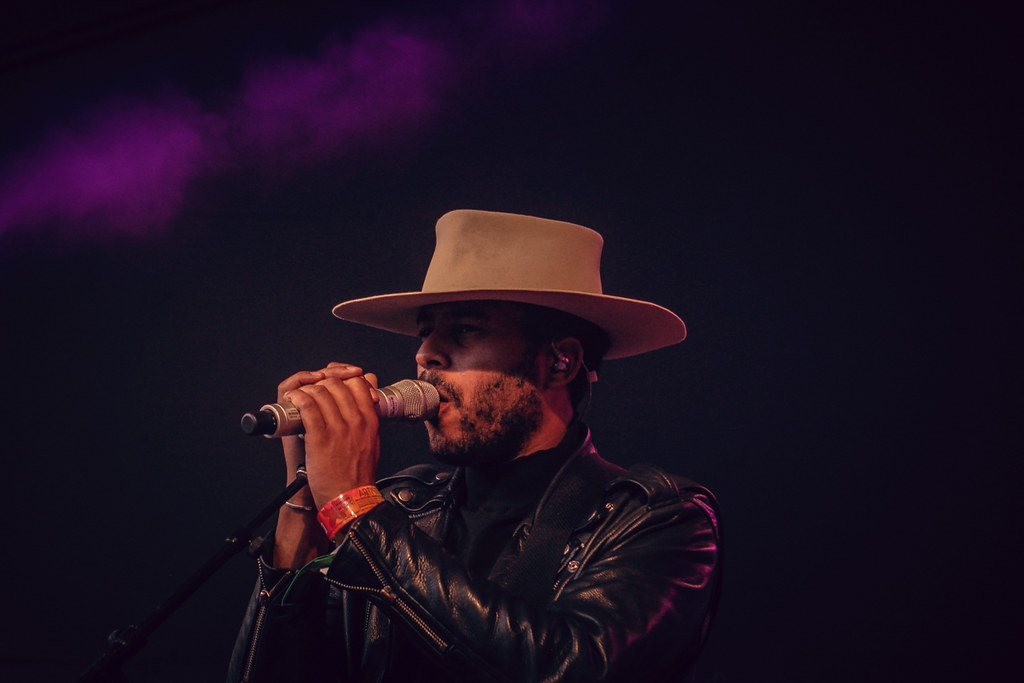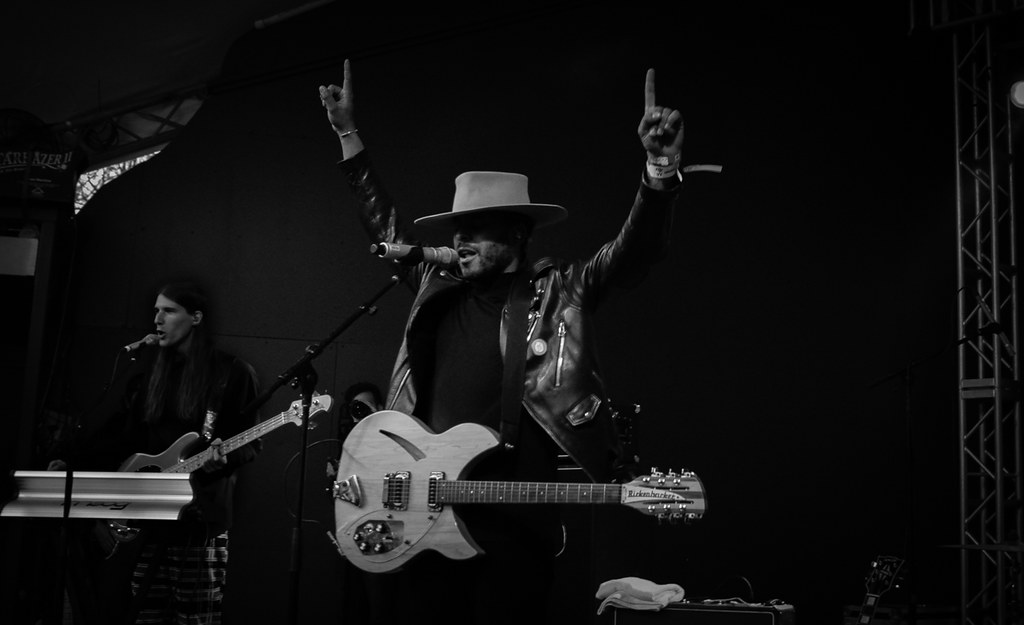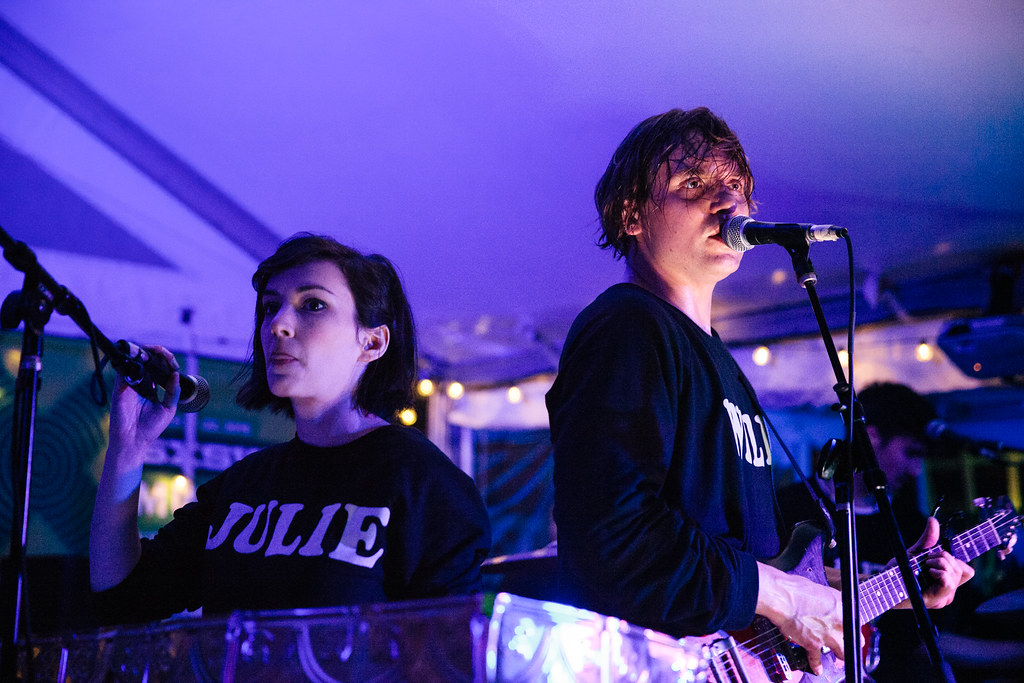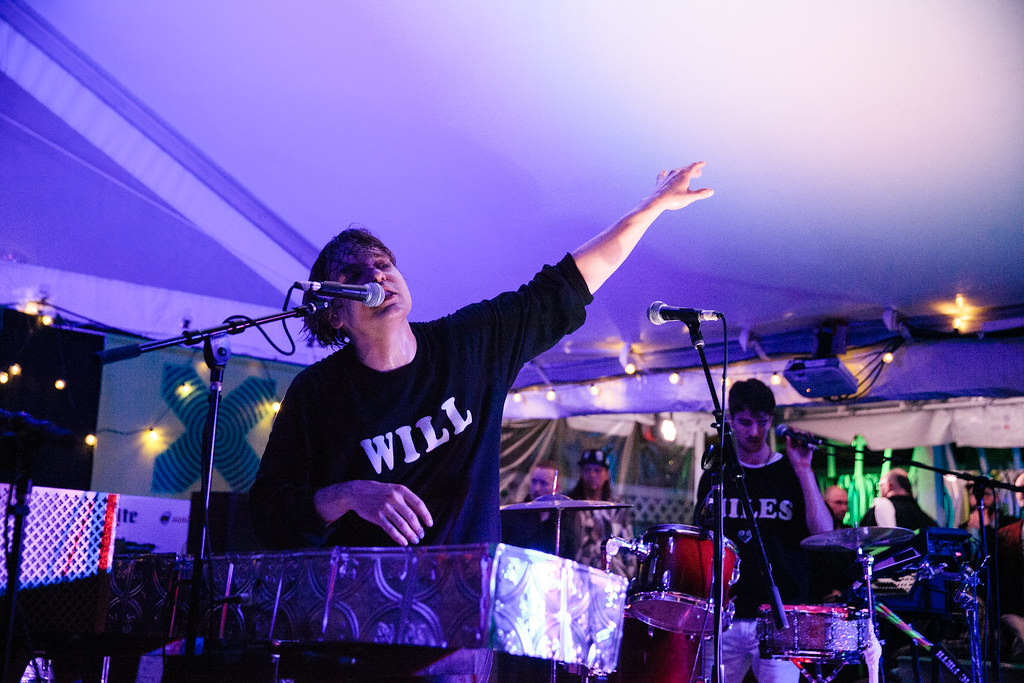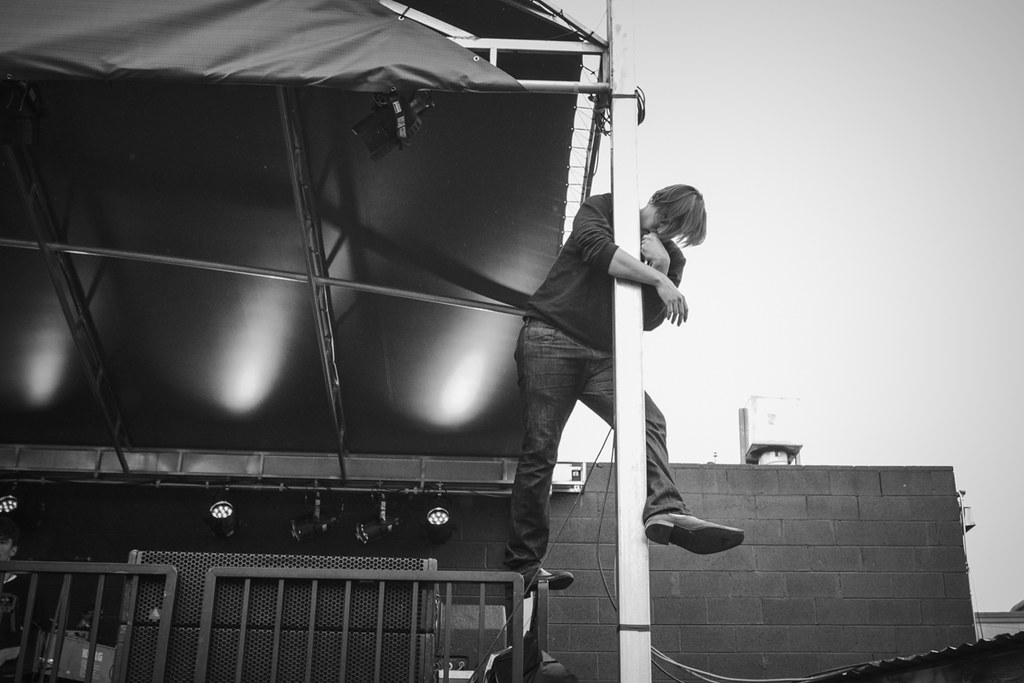We’ll have more atmospheric and cultural observations on SXSW tomorrow in our written and visual festival diary. For now, though, let’s keep it with the music.
Alphabetically, here’s who Hear Nebraska covered the last two days of SXSW 2015:
Atmosphere, Bonehart Flannigan, Brother Ali, Buffalo Rodeo, Con Brio, Darren Keen, Dirty Few, Earl Sweatshirt, The Everymen, Field Mouse, Hiatus Kaiyote, Ibeyi, Icky Blossoms, Kate Tempest, The Kickback, La Luz, The Mynabirds, New Myths, Nikki Lane, Orenda Fink, Pujol, Residual Kid, Rubblebucket, Screaming Females, Springtime Carnivore, Tobias Jesso Jr., Torres, Twinsmith, Twin Shadow, Will Butler.
* * *
Atmosphere at The Mohawk
photo by Kyle Gibson
* * *
Bonehart Flannigan and Dirty Few at an Austin House Show
Three miles south of Sixth Street, SXSW’s epicenter, the reverberations from the mega-festival are barely noticeable. Life outside the festival pushes on: a mother in a minivan drives children to a friend’s house. A middle-aged man works behind the counter at a Conoco. Traffic flows normally through intersections, not blocked off ends stopped-up by scores of wandering festival-goers.
In fact, in south Austin, you may be able to forget altogether about the commercial monster enveloping most major parts of the city just a few miles away. But at Blind Pets frontman Joshua Logan’s house, buried deep among these neighborhoods, pieces of SXSW have trickled out.
The Austin band befriended Bonehart Flannigan’s Jon Dell when Dell was booking at Duffy’s in Lincoln. When Dell had a SXSW show fall through, Blind Pets members wanted to make sure he had a place to play. So they threw a six-band house show.
In a way, one of the least typical SXSW shows also felt the most normal, like any other house show you might attend in Austin during the other 51 weeks of the year. This showcase isn’t sponsored by a record label or a music streaming service or a particularly savvy insurance company.
There’s a free keg and a friendly pit bull making laps around the yard. The 30 or-so people in attendance all seem to know each other, even though most of them don’t. And most are not wearing the green “I’m at SXSW” wristband.
photos by Andrew Dickinson
Denver rock trio Dirty Few plays before Bonehart Flannigan — a classic, loud and disorganized weekend rock ‘n’ roll, complete with falling into the audience and sharing the microphone with Logan from time to time. Twice in a row, without missing a beat, vocalist Kim Phat spits a thick loogie into the air and catches it back in her mouth.
Between sets, everyone ditches the cleared-out living room to mill around the backyard. Dell steps out onto the backyard’s deck with an acoustic guitar in hand. Without microphone or amp, he strums the same chord progression for a comically long time until he has everyone’s attention.
When Dell’s set gets going, he plays mostly Bonehart staples like “Get in the Van, Let’s Go,” “Sweet Release,” “Hot Mess” and “Backpacks and Mason Jars,” as well as a few new ones, which he warns are “sad as fuck,” as if every song doesn’t pair hard-luck situations with charming winks.
At this rock ’n’ roll house show, Bonehart’s somber country-folk is received with the laugh-to-keep-from-crying recognition. Sonically, Dell makes more sense on a Sower Records billing, but here, with so many of his songs essentially about the classic rock and roll lifestyle, he serves as a Shakespearean chorus, a minister of meta-commentary on the mothers we’re not calling back and the cheap beer we’re over-serving ourselves.
Though this might be the only place in Austin today that the non-VIP could even be over-served.
When Logan thanks everyone for coming out to support his friends, he jokes that “each beer will be $8” and most people have already had at least a few. As with Dell’s songs, we laugh at the depressing reality of the statement.
—Jacob Zlomke
* * *
Brother Ali at The Mohawk
photo by Kyle Gibson
* * *
Buffalo Rodeo at Goorin Bros. Hat Shop
“I don’t know if it’s normal for people to play covers at SXSW,” Buffalo Rodeo frontwoman and keyboardist Jordan Reynolds begins at Goorin Bros. Hat Shop. “But we’re going to start with a cover.”
It’s hard to talk about normal, though, when you’re playing in the middle of a high-end hat store, serving free grapefruit-flavored vodka. “Normal” further loses its meaning when half the audience is walking around in hats they clearly didn’t leave the house with today.
The Bowling Green-based band released its 123 Water EP earlier this month. Like the EP, Buffalo Rodeo’s live set is a psychedelic take on ambient indie pop, thanks in large part to Reynolds and Zach Preston’s twin vocals that twist around each other in double-helixes.
Guitar work fits as well in Goorin’ Bros. as it might at ‘70s rock club with live projections cast behind the band.
Even if the specific location of the show seems odd, Buffalo Rodeo rolls with it and at some point, audience members settle on one hat to take them through the rest of the show, a sign of Buffalo Rodeo’s power to grab attention.
—Jacob Zlomke
photos by Andrew Dickinson
* * *
Con Brio at Palm Door on Sabine
photo by Kyle Gibson
* * *
Darren Keen at Cheers Shot Bar
You’d probably only think of this if you’d watched four days of sound checks, ranging from the slick to the finicky to the arduous. But kudos to the DJs at Cheers Shot Bar for having expedience, the audience and maximizing their own set times in mind.
The recent Nebraska ex-pat Darren Keen respectfully climbed under the tent to prepare when Archnemesis was finishing up his set. Then, a quick: “Hey, I’m Darren Keen from Brooklyn, New York.” And then it was off into Keen’s intricate and performative songs, juxtaposed beats and deft MPC tapping.
While Keen’s recent EP Roland Is My Co-Pilot exemplifies this quality in his footwork music, you can find a contrast in Keen’s current interests that runs through many of his old projects, The Show Is The Rainbow, Touch People, etc. There’s a sense of child-like fun mixed with a zealous sense of the grotesque. With the rain letting up at Cheers, Keen dealt out a mix of tropical and sped-up, ’50s melodies (complete with one steel drum part), broken up by the sounds of demonic laughter.
The set’s best flourishes came in the form of a well-schooled musician making a difficult task look easy and enjoying it. After a left hand roll on the effects pad that would make any ragtime piano player proud, Keen feinted once with his right hand, like a boxer toying with an overmatched opponent. Moments later, he mimed a bass drop with a hip-turning baseball swing.
—Chance Solem-Pfeifer
photos by Bridget McQuillan
* * *
Earl Sweatshirt at Stubb’s
photos by Chris Dinan
* * *
The Everymen at 720 Club
It’s an encouraging, if not surprising, fact that The Everymen is headed to Alabama’s famous Muscle Shoals studio after SXSW to record its new record.
In the cramped room of 720 Club, which we mentioned the other night mandates anything more than a trio is going so spill off the stage, the New Jersey band walloped the room with sound too big, too classic and with its interworking too polished to fully stretch out in that setting. But what you could see unfolding around you was quite the rock album.
As the follow-up to 2014’s Givin’ Up On Free Jazz, this record figures to see Catherine Herrick’s singing voice as vital. At 720 Club, you could see (more than hear) her hitting falsetto notes that would shoot a record through with passion and its saxophonist actually strumming his alto like a guitar. Then, he switched to baritone for a longer, more entrenched rock ‘n’ roll number. There’s a record they hear in their heads. On drums, Nebraskan Mitch Cady, formerly of the Lincoln punk band Bandit Sound, dictated the group’s furious pace, a hallmark of Bandit Sound’s speeding choruses.
And while the room is what the room is, it seems that venues like 720 Club play an earnestly important role at SXSW. Between this and Publicist UK on Wednesday night, the venue seemed to attract 25-30 legitimately curious pairs of ears in SXSW lanyards and with notebooks. Not something you can say for the buzziest SXSW showcases, where the crowd sometimes seems more interested in being in front of the band than having the band in front of it.
—Chance Solem-Pfeifer
photos by Bridget McQuillan
* * *
Field Mouse at Cheer Up Charlies
If any instrument could be said to reign at SXSW, it’s a heavily distorted lo-fi electric guitar. See: Torres, New Myths, La Luz and on and on down the lineup.
At Cheer Up Charlies, Field Mouse was one of the instrument’s foremost champions. For the New York-Philadelphia-based quartet, that means a thick, fuzzed wash of instrumentation over which Rachel Brown’s voice swims saccharine.
Field Mouse, which released its debut album, Hold Still Life, last year, is at its most exciting, though, when guitarist Andrew Futral competes with Brown’s voice rather than supports it. Hard-edged guitar lines occasionally break the opium-haze to jolt the song awake.
Until then, Field Mouse is reminiscent of so many other recent bands to harken Dinosaur Jr. and Sonic Youth that it might be fair to ask, “Remind me who this is?”
But when Futral’s guitar is allowed to come alive, there’s a certain energy, a break-away from the apathy that naturally plagues sleepy genres like shoegaze.
—Jacob Zlomke
photos by Andrew Dickinson
* * *
Hiatus Kaiyote at Bungalow
photos by Chris Dinan
* * *
Ibeyi at Central Presbyterian Church
photos by Chris Dinan
* * *
Icky Blossoms at Red Eyed Fly
Closing Saddle Creek’s showcase, Icky Blossoms overcame a few technical difficulties to deliver a high-energy live set.
It feels appropriate that the final day of the massive festival, after miles of walking and waiting in line and days of drinking and not-sleeping, would require some perseverance.
For whatever reason, the band’s backtrack had some trouble getting off the ground which meant some “acoustic” versions of familiar Icky Blossoms songs. But with a live drummer (Skypiper’s Ryan Menchaca) in-tow, the missing backtrack was hardly noticeable. And the small setback didn’t hinder the band’s stage presence, always as into their own songs as the audience.
Icky Blossoms sometimes reads like an on-stage competition between Derek Pressnall and Nik Fackler. Who can most emphatically jump around? For what it’s worth, Saturday night would have been a draw.
photos by Bridget McQuillan
Even after five (or six) days attending shows and a long day of traveling ahead for bands and audience alike, it’s hard not to get wrapped up in the sheer joy of performing the band cultivates.
New tracks, presumably from the band’s forthcoming Masks, tend more toward the “Heat Lightning” end of the Icky Blossoms spectrum than “Perfect Vision.” Songs rely on a prominent, grooving rhythm section and layers of percussive synthesizers.
As an appropriate symbol of the showcase’s communion, Fackler at one point has to borrow Twinsmith frontman Jordan Smith’s guitar.
Vocalist/keyboardist Sarah Bohling seems burnt out on being advertised at. Understandable after a week of sponsored showcases. She repeatedly requests that the TVs behind the bar be turned off. To be fair, they’re directly in her line of vision.
“I can’t stop watching this commercial,” she says. “Now, I really want those towels.”
— Jacob Zlomke
photos by Andrew Dickinson
* * *
Kate Tempest at Red Eyed Fly
photos by Chris Dinan
* * *
The Kickback at Maggie Mae’s
In previewing the youthful Chicago band Twin Peaks’ show in Nebraska last year, our staff writer asked its bassist about what its name — borrowed from the cult-appreciated David Lynch TV show — projected about the band’s cultural awareness. Jack Dolan explained with a shrug and laugh that the band just likes TV. End of story, effectively.
But there’s cultural cache in a name like “Twin Peaks,” gesturing at something else cool, piggybacking some. It’s no great crime. But it’s a little easy.
Then, you watch The Kickback’s Billy Yost, dripping sweat, espousing at his traditionally over-caffeinated clip (perhaps even more on this night) what professional wrestling and Twin Peaks mean to him, as he introduces “Head Hunter” and “White Lodge,” respectively. Reference within the songs is oblique, hard to arrive at — just like most of the band’s lyricism — even if the wit prevails. But the calling out of ’90s images is not emotional detachment; it’s bondage. It’s the pronounced feeling that pop culture experiences steep us to the point of overflowing intensity. I guess we know that feeling already. It’s just that it’s a lot harder — riskier, if you’re the author — to do it in a multi-movement, rock song than a comment section.
Onstage, through playing a fiery lead guitar, Jonny Ifergan looks like he’s being happily electrocuted and Yost’s mouth looks full of spit, as he stoops low, trying to lose control of his body. It’s the cathartic and violent look of a band embattled with its own goals: touring endlessly, trying to release its Jim Eno-produced debut record for two years now.
Nights earlier, Eamonn Donnelly’s bass cab exploded during their previous SXSW show, and Billy is currently sleeping under a motel desk. It’s a corner he chose, the singer also notes.
Through “Rob Our House,” “Fanger” and “Sting’s Teacher Years,” The Kickback is clinging furiously to something within these songs. Two years since recording many of them, the white-knuckling is enrapturing.
—Chance Solem-Pfeifer
photos by Bridget McQuillan
* * *
La Luz at Buckshot
The bass guitar reigns in surf music, especially the darkish surf rock that thrives in the world of Best Coast, etc. The lead guitar is probably flying around, soundtracking a boogie board gliding and nosediving. The drums are everywhere.
And in surf rock as sonically skinny as La Luz’s, the bass’ role is all the more pronounced. Lena Simon was in charge of melody and staunch backbone at the Seattle quartet’s Buckshot set on Friday. In front of Juxtapoz magazine’s white-sheet showcase backdrop — that looked like a yearbook in bleeding memory, with muddy, blurred faces — the band seemed both cordial and scary. Which is the another musical quality of such surf music, sewing the seeds of fun, but with rushing minor riffs that makes the whole thing seem like a grave race.
With all four members mic’d up and hand-clapping on either, they exuded a real geniality toward each other. Which reveals a facet of stage manner and mood at SXSW. Where do you turn when things are imperfect? Bad-sounding rooms, undertrained sound engineers, faulty equipment, crowds in their valley of their day, stone drunk at 5 p.m.
Certainly, La Luz didn’t face all this, but many bands at SXSW dealt with some variety and degree of those setbacks. If the crowd was a bit sleepy, these women looked to the inner-workings of the band for joy: keyboardist Alice Sandahl mugging at drummer Li Pino, finding zest in the songs and what their performance on any given stage meant for relationships forged years prior.
—Chance Solem-Pfeifer
photos by Bridget McQuillan
photo by Andrew Dickinson
* * *
The Mynabirds at Red Eyed Fly
Nowhere is the foundation for The Mynabirds and the exigency for it to be “birds”-plural more apparent than when Laura Burhenn plays 2012’s “Generals,” a rolling and, at times, menacing protest song.
As the second act of Saturday’s Saddle Creek showcase, Burhenn capped off a week of intimate shows with just her and and a keyboard, essentially teasing a forthcoming Saddle Creek album, that’s been announced but has no release date.
Doing “Generals” on Saturday as a bare, synth clap-along may have felt incomplete, but shone brightly on the chief mechanism behind it and a lot of other Mynabirds songs. Burhenn’s writing on piano is brilliantly married to her voice, rarely ever chords that sit idly. And when she uses her voice low and high with a harmony effect on, it’s almost like two different instruments.
The emotional highpoint of the set was the closer, “What We Lose In The Fire We Gain In The Flood,” a big, pounding ballad Burhenn said she started writing at her first SXSW. With her sense of the quiet, reverent pageantry, Burhenn’s set felt the most at home that night, foregrounding Red Eyed Fly’s odd stage aesthetic, a kind of kitchy cabin homeyness, low-rafted ceilings running against, plushy maroon curtains.
—Chance Solem-Pfeifer
photo by Andrew Dickinson
* * *
New Myths at Cheer Up Charlies
photos by Andrew Dickinson
* * *
Nikki Lane at Buckshot
Opening with a faithful cover of Joan Jett’s “I Love Rock ‘n’ Roll,” Nikki Lane set some bold expectations for her band’s set at Buckshot. Generally, the best covers are reinterpretations, versions of the song that feel new and owned by the band. But by inching herself as close to Jett’s original as possible, even matching in vocal fury, Lane seems to say one thing: “I could do Joan Jett’s job.”
And by all accounts, that’s the case. Granted, Lane and company tend more toward country-rock than the blues rock of The Blackhearts, but she’s equally ferocious in a vein of music where virility is reserved and celebrated for frontmen, not women.
And to that end, she’s runs the gamut of rock ‘n’ roll tropes. On “Highway Queen,” she claims ownership of the open road, where she says she practically lives. She sings one song about “being stoned as fuck in a tiny little town” and talks about partying too hard during the festival.
At its most triumphant, the recently divorced Lane pulls her wedding ring off during the middle of the song. Her raised hands turn to middle fingers, and the audience cheers.
It’s not that I or anyone else bears any particular ill-will toward some unnamed person. But like I wrote about in regards to Shishi Sakari at the Hooligan Showcase, dismissive rage feels therapeutic. Like much good art, it lets its audience know that they aren’t alone, that, at least by one other person’s standards, the way they’ve felt is normal.
And the difference between watching a woman express those feelings instead of a man? It feels new, this way, even in a well-trod genre. Like watching someone reclaim the rights to their own emotional narrative.
—Jacob Zlomke
photos by Andrew Dickinson
* * *
Orenda Fink at Red Eyed Fly
At least at SXSW last week, there were two versions of Orenda Fink — the album version driven by rhythmic bass grooves and powerful, yet gentle, percussion on last year’s Blue Dream — and the stage version.
The stage version partners Fink with husband Todd Fink of The Faint. With Orenda on guitar and Todd on keyboards, familiar songs like “Ace of Cups” rely less on a solid rhythm section and more on heightening atmosphere, with Orenda looping ambient vocals back onto themselves into infinity.
Tracks from Blue Dream and much of Fink’s catalogue, including her work with Azure Ray, always cast itself somewhere toward the angelic, but these iterations are perhaps the most free-floating. Without palpable percussion, songs drift upward and upward on themselves. Like endlessly folding a piece of paper it feels both less expansive and more towering.
Fink has been touring Blue Dream hard over the last year, but people haven’t forgotten her beloved work with Azure Ray. Her announcement that she’ll play one of the band’s tracks is met with fervent cheers.
The Saddle Creek showcase may as well have been a Nebraska meet-up, there to celebrate some of the state’s finest work and Fink was no exception. It’s rewarding to see her play out of the familiar Omaha context and how her work takes on its own life on the road.
—Jacob Zlomke
photo by Andrew Dickinson
* * *
Pujol at Red Eyed Fly
photos by Andrew Dickinson
* * *
Residual Kid at The 512
photos by Bridget McQuillan
* * *
Rubblebucket at Scoot Inn
photos by Bridget McQuillan
* * *
Screaming Females at Stubb’s
photos by Chris Dinan
* * *
Springtime Carnivore at Hideout Theater
photos by Chris Dinan
* * *
Tobias Jesso Jr. at Central Presbyterian Church
photos by Chris Dinan
* * *
Torres at Scoot Inn
photo by Andrew Dickinson
* * *
Twinsmith at Red Eyed Fly
photos by Bridget McQuillan
* * *
Twin Shadow at Stubb’s
photos by Chris Dinan
* * *
Will Butler at Maggie Mae’s
Earlier on Friday, Will Butler scaled a stage pole at Stubb’s. Cornered in the upstairs horseshoe of Maggie Mae’s rooftop stage, any acting out was reserved for tapping into the goofy and electric exaggeration of his music. Except, that is, for a series of black sweatshirts in block lettering with the band members’ names on them: Will, Sara, Julie, Carrie and Miles. Like they were characters on a hokey kids’ show.
Butler, the younger brother of his Arcade Fire bandmate Win, released his debut album, Policy, earlier this month to critical praise. It’s much simpler than Arcade Fire, but because of Will’s composing importance in the Canadian behemoth, this project’s underaterrable energy creates a feeling of pointed kinsman ship to Arcade Fire’s work.
The set opened with “Take My Side” and “Anna,” the two singles from the album. The latter, as evidence in its roadside music video, is when Butler can cut loose the most, breaking into some on the shaky leg dancing that makes the video such a funny vanity project. But far-and-away the most dramatic musical moments of his sets are when he steps to the piano, the instrument on which he’s considered a core component of Arcade Fire. Sudden crystalline chops break up “Anna” and “Witness” thrives on a driving gospel beat. Butler attacks the keys two-handed in staccatos, cracking up his pop music with a few Jerry Lee Lewis bursts.
He’s in Omaha in June. Everything about his sensibility is a recipe for excitement.
—Chance Solem-Pfeifer
photos by Bridget McQuillan
Will Butler at Stubb’s (earlier that day) by Chris Dinan




